Live plants in an aquarium provide so many benefits. But, it can be daunting to figure out which plants to start with if you’re a beginner.
In the many years that I’ve been keeping aquariums in my home, I’ve kept a slew of beginner friendly plants that I’d like to share with you today.
In fact, I had most of the plants from this article in my tanks already. I know these plants are hardy and beginner friendly from my own experience, so I felt comfortable discussing them out of hand.
But, for some added insight, I bought 14 new specimens and planted them in a new tank so you can see what it’s like when you order aquarium plants. I then recorded how beginner friendly each plant is and compared them against each other.
Top 5 Aquarium Plants I Recommend for Beginners
After buying, planting, growing, trimming and caring for different freshwater aquarium plants, here are my 5 most beginner friendly plants out of the 14 I tested.
Java Fern (Leptochilus pteropus)
Key Info:
- Scientific name: Leptochilus pteropus
- Temperature range: 68°-82°F (20°-28°C)
- Lighting requirement: Low light (PAR <50)
- Tank placement: Mid to background
- Planting: Epiphyte so attach to hardscape
- Water Column Feeder
Why I recommend for beginners
I think this is the best, most beginner friendly plant out there; this is where you should start.
Pros & Cons
Pros
Easy to plant
Extremely tough and versatile
Bright green leaves
Grows a bit faster than anubias
Cons
Grows slowly
A bit harder to clean algae off leaves than anubias

Overall Score: 8.8/10
In-depth Scoring
Planting: 10/10
Trimming: 10/10
Algae Control: 7/10
Sensitivity: 10/10
Hardiness: 10/10
Aesthetics: 9/10
Availability: 10/10
Cost: 9/10
Compatibility: 9/10
Contributions: 4/10
Amazon Sword (Echinodorus grisebachii)
Key Info:
- Scientific name: Echinodorus grisebachii
- Temperature range: 68°-82°F (20°-28°C)
- Lighting requirement: Medium to High (PAR 50-80)
- Tank placement: Mid ground
- Planting: In substrate
- Heavy root feeder
Why I recommend for beginners
Very easy plant to care for. Its a classic and beautiful plant everyone should own at least once.
Pros & Cons
Pros
Beautiful
Easy to plant
Helps eat excess nutrients in the substrate
Provides good cover for small fish
Low maintenance
Cons
Gets very large over time and can only be trimmed back so much
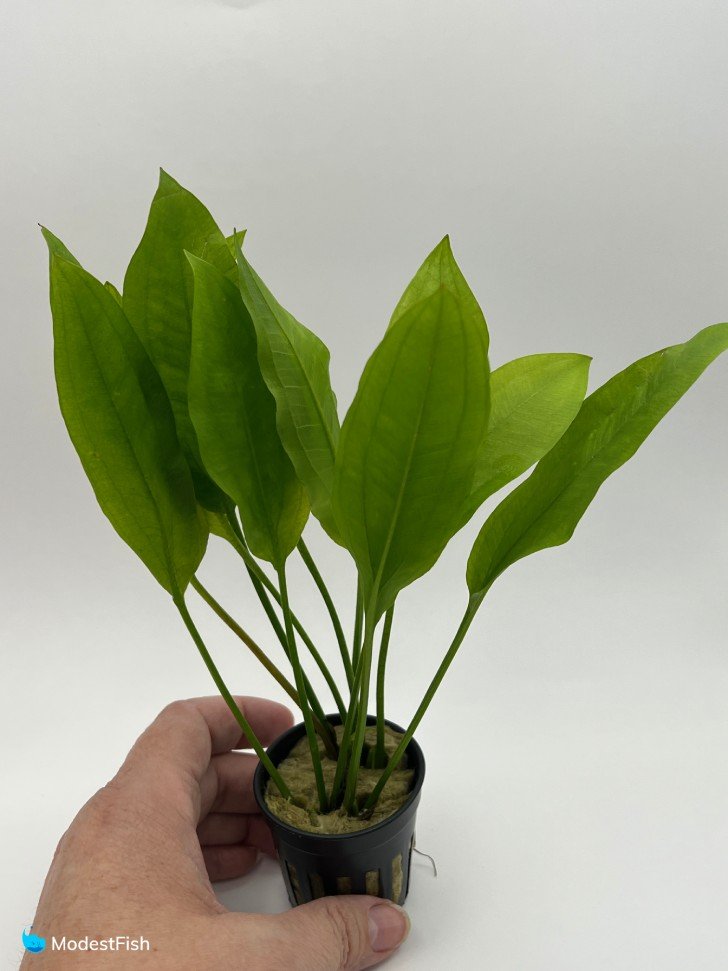
Overall Score: 8.5/10
In-depth Scoring
Planting: 9/10
Trimming: 9/10
Algae Control: 7/10
Sensitivity: 10/10
Hardiness: 9/10
Aesthetics: 10/10
Availability: 10/10
Cost: 9/10
Compatibility: 7/10
Contributions: 5/10
Anubias barteri
Key Info:
- Scientific name: Anubias barteri
- Temperature range: 72° – 82° F (22° – 27° C)
- Lighting requirement: Low light (PAR <50)
- Tank placement: Mid to backround
- Planting: Epiphyte so attach to hardscape
- Water column feeder
Why I recommend for beginners
My favorite of the smaller anubias varieties, a great beginner plant, with broad leaves that are simply gorgeous.
Pros & Cons
Pros
Easy to plant
Likes low light
Easy to get algae off leaves
Requires little fertilization
Not sensitive
Cons
Grows slowly
Doesn’t contribute that much to water parameters
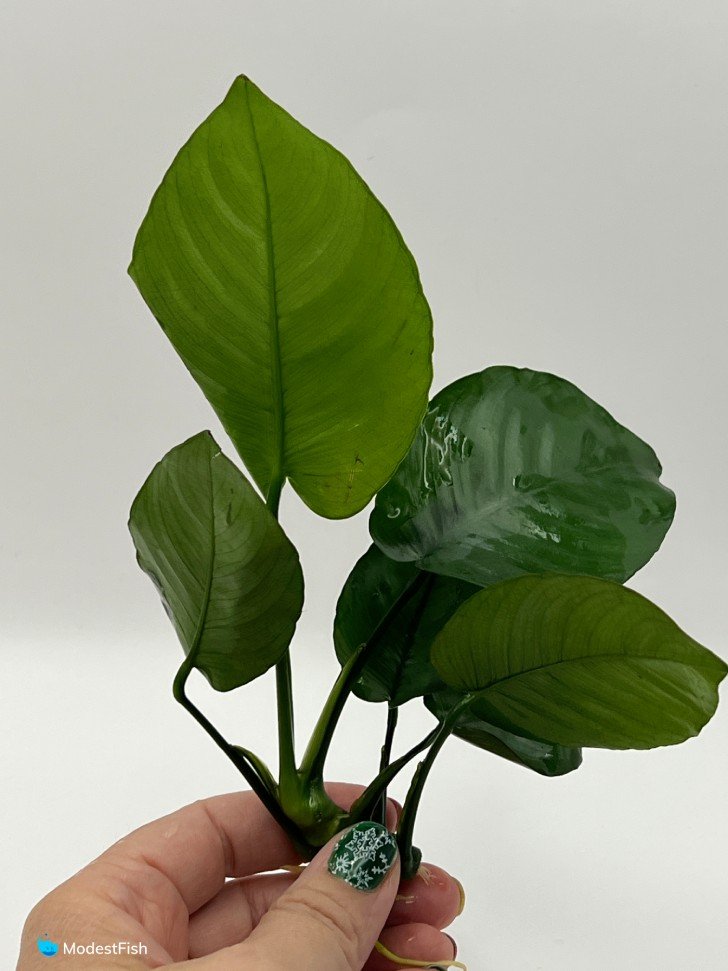
Overall Score: 8.5/10
In-depth Scoring
Planting: 10/10
Trimming: 10/10
Algae Control: 8/10
Sensitivity: 10/10
Hardiness: 10/10
Aesthetics: 10/10
Availability: 9/10
Cost: 8/10
Compatibility: 7/10
Contributions: 3/10
Anubias congensis
Key Info
- Scientific name: Anubias congensis
- Temperature range: 68°-82°F (20°-28°C)
- Lighting requirement: Low light (PAR<50)
- Tank placement: Mid to backround
- Planting: Epiphyte so attach to hardscape
- Water column feeder
Why I recommend for beginners
You don’t need a lot of tech to have this plant thrive. This large anubias species can be a great centerpiece in a low light tank.
Pros & Cons
Pros
Easy to plant
Likes low light
Easy to get algae off leaves
Requires little fertilization
Not sensitive
Cons
Grows slowly
Doesn’t contribute much to water quality
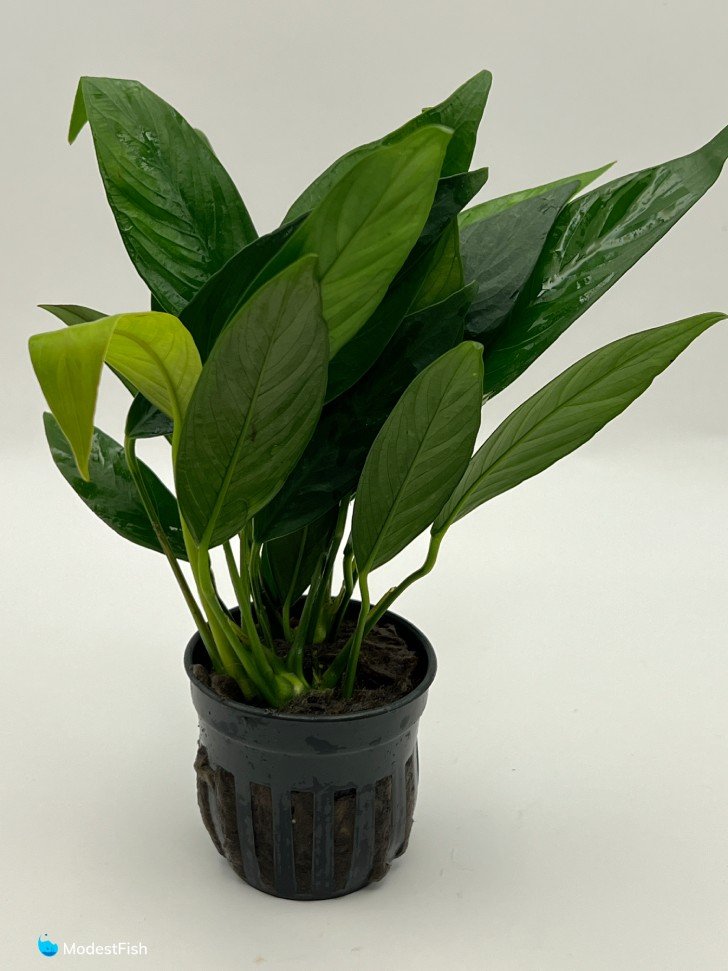
Overall Score: 8.5/10
In-depth Scoring
Planting: 10/10
Trimming: 10/10
Algae Control: 8/10
Sensitivity: 10/10
Hardiness: 10/10
Aesthetics: 9/10
Availability: 9/10
Cost: 8/10
Compatibility: 7/10
Contributions: 4/10
Anubias nana
Key Info:
- Scientific name: Anubias nana
- Temperature range: 68°-82°F (20°-28°C)
- Lighting requirement: Low light (PAR<50)
- Tank placement: Fore to mid ground
- Planting: Epiphyte so attach to hardscape
- Water column feeder
Why I recommend for beginners
This dwarf species of anubias is super cute and perfect for smaller beginner setups with limited space.
Pros & Cons
Pros
Easy to plant
Likes low light
Easy to get algae off leaves
Requires little fertilization
Not sensitive
Cons
Grows slowly
Doesn’t contribute much to water quality
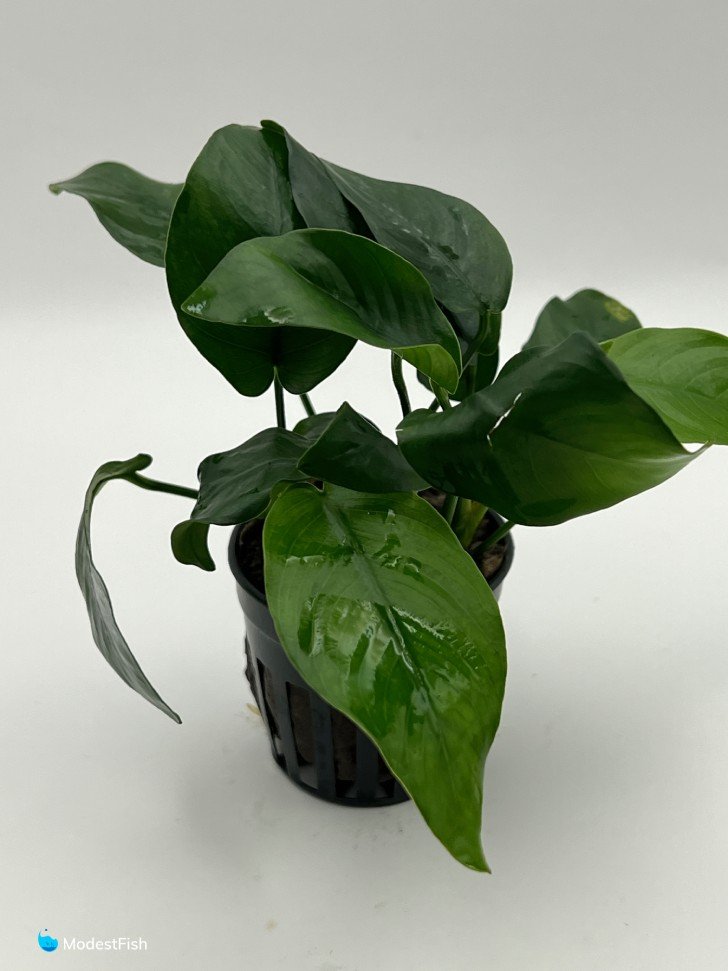
Overall Score: 8.5/10
In-depth Scoring
Planting: 10/10
Trimming: 10/10
Algae Control: 9/10
Sensitivity: 10/10
Hardiness: 10/10
Aesthetics: 9/10
Availability: 10/10
Cost: 8/10
Compatibility: 7/10
Contributions: 2/10
Plants I Bought, Tested and Scored
All the plants reviewed in this list are great choices for beginners. However, some score low because they may not contribute as much to your tank’s eco-system as others or may be more sensitive than others on the list.
The purpose of the scoring is to help you understand the pros and cons of each plant and which are more well-rounded in terms of ease of care and helping keep parameters stable.
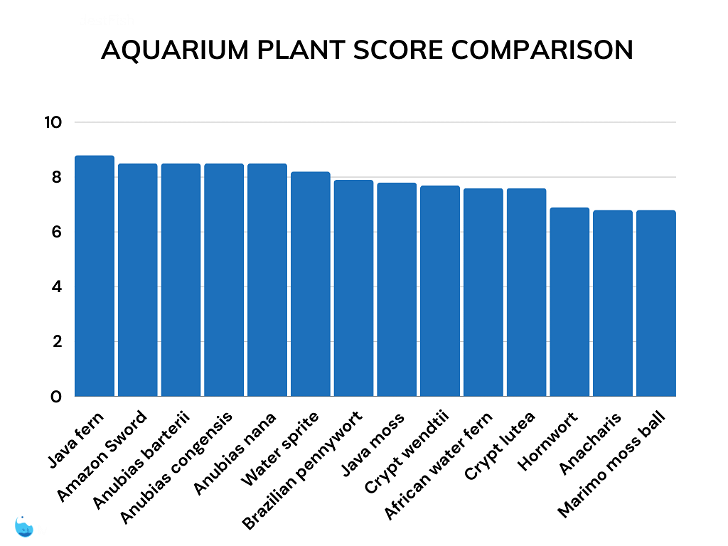
- Java fern (8.8/10) I think this is the best, most beginner friendly plant out there; this is where you should start.
- Amazon sword (8.5/10) Classic and beautiful plant everyone should own at least once, but needs a large tank long-term.
- Anubias barteri (8.5/10) My favorite of the smaller anubias varieties, a great beginner plant, with broad leaves that are simply gorgeous.
- Anubias congensis (8.5/10) This large anubias species can be a great centerpiece in a low light tank.
- Anubias nana (8.5/10) Dwarf species of anubias is super cute and perfect for smaller setups.
- Water sprite (8.2/10) Fast growing stem plant is great for reducing nitrate in the water column, but does need frequent trimming and replanting.
- Brazilian pennywort (7.9/10) Awesome floating plant that eats up nitrate directly from the water column and looks like a string of tiny lily pads.
- Java moss (7.8/10) Grows in a crazy quirky tangle that is an excellent habitat for shrimp and baby fish.
- Crypt wendtii (tissue culture) (7.7/10) Small crypt is a great foreground plant for smaller tanks, but it is very sensitive to large swings in parameters.
- African water fern (7.6/10) A is slow growing, especially the first few months, but it’s hardy, beautiful and a great background plant for larger tanks.
- Crypt lutea (7.6/10) A gorgeous foreground plant in medium to large tanks and will spread along and cover the substrate in a messy carpet, but it’s very sensitive to changes in the water.
- Hornwort (6.9/10) Fast growing plant that can eat up a lot of nitrate, but getting it established can be tricky.
- Anacharis (6.8/10) Grows very quickly, so it can be a pain to trim, but it does a great job removing nutrients from the water column.
- Marino Moss balls (6.8/10) These slow growing little moss balls are really cute and simple to care for.
How I Reviewed The Plants For Beginner Friendliness
For each plant I considered the following:
- Planting – how easy or difficult is it to place the plant in the tank?
- Trimming – how often do you have to trim the plant and how hard is it to do?
- Algae control – how hard is it to keep the plant algae free?
- Sensitivity – how sensitive is the plant to changes in the water parameters? This is different from hardiness. Some plants are hardy, but sensitive. Changes in the water parameters may cause some plants to suddenly drop all their leaves and “melt” back. The plant is still hardy, and will recover eventually, but sudden shifts will cause sensitive plants to have a dramatic response.
- Hardiness – how resistant is the plant? How much effort does it take someone to keep it alive and healthy.
- Aesthetics – how attractive does the plant look? Yes, this is really subjective, but it’s still worth mentioning.
- Availability – how easy is it to get the plant at live fish stores and/or online?
- Cost – how expensive is the plant? Again, somewhat subjective, but how big of a plant do you get for the price you pay?
- Compatibility – how many different kinds of fish can you keep the plant with? For example, delicate plants can only be kept with small, gentle
- Contributions – how much of an effect does this plant have on eating up excess nutrients, like nitrate and ammonia, in the water column? Fast growing plants tend to have more of an impact on water quality than slow growing plants.
Best Plants For Beginners Compared & Reviewed
1. Java Fern (Leptochilus pteropus)
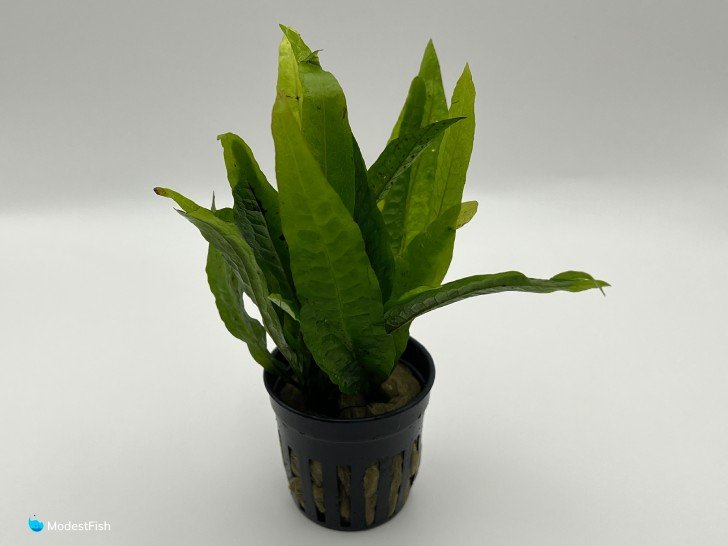
Verdict – I think this is the best, most beginner friendly plant out there; this is where you should start.
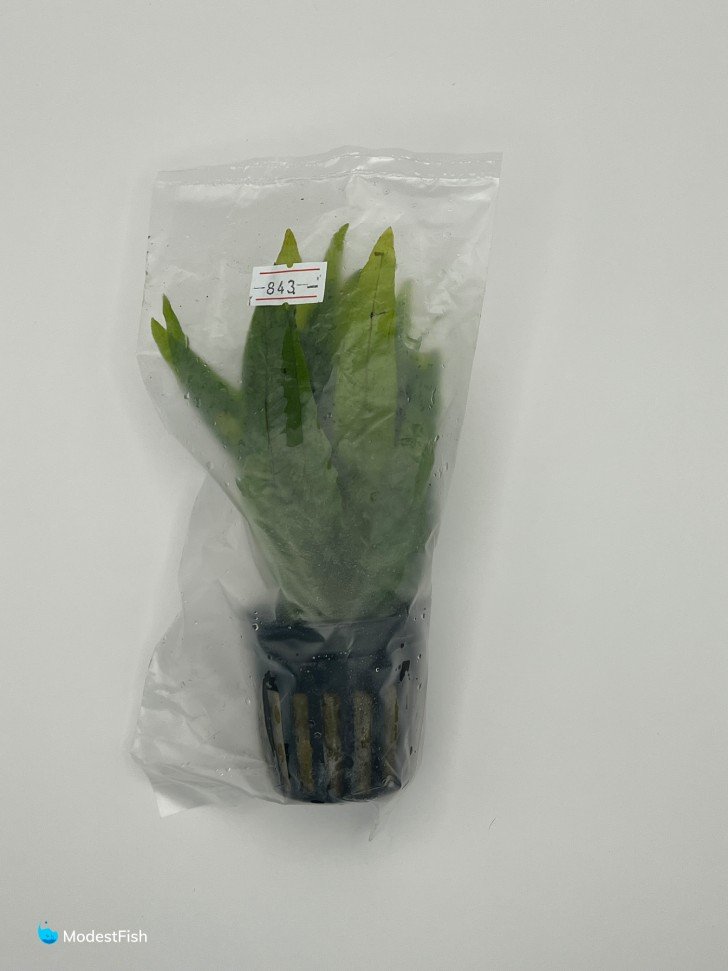
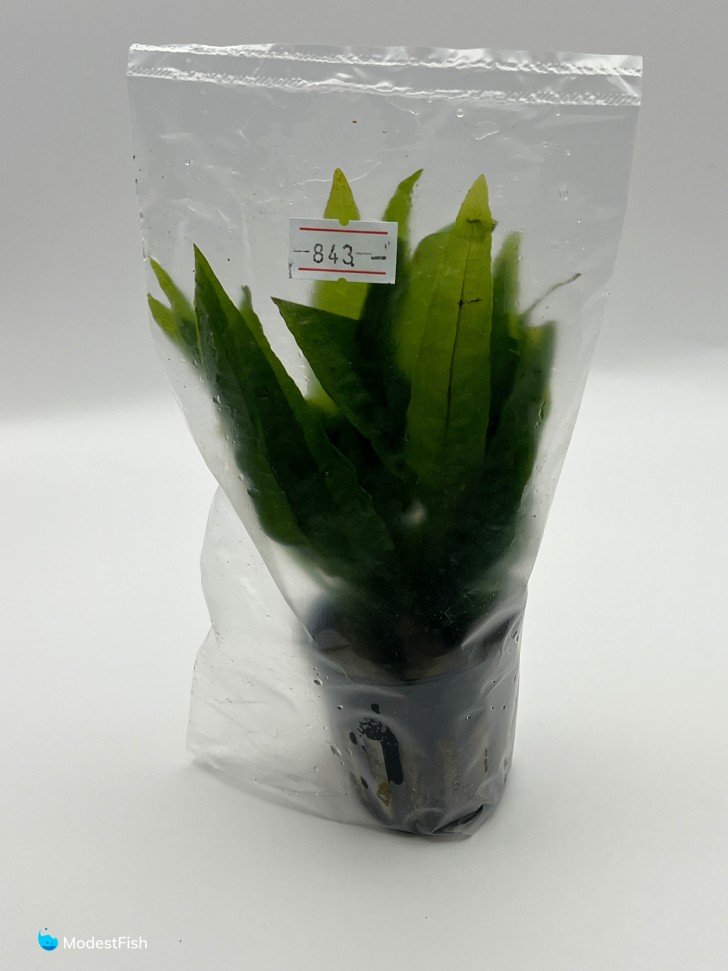
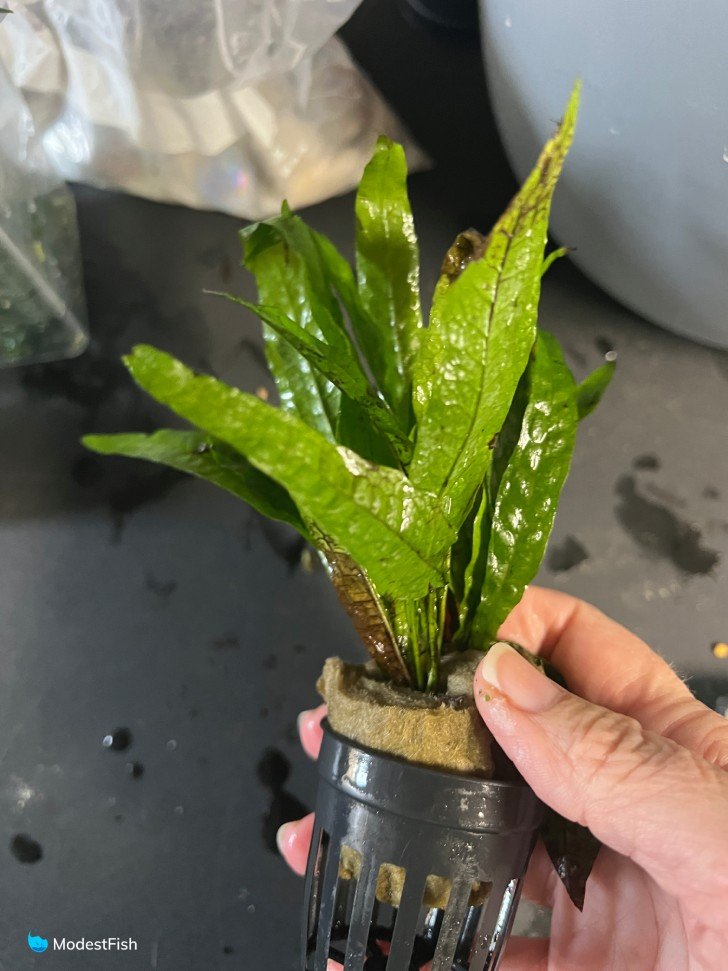
I love Java fern, I have it in several of my tanks. Over the years, it’s proven to be super hardy and simple to take care of.
It is an epiphyte, a plant that lives on the surface of things like rocks or sunken logs rather than being rooted down in the substrate.
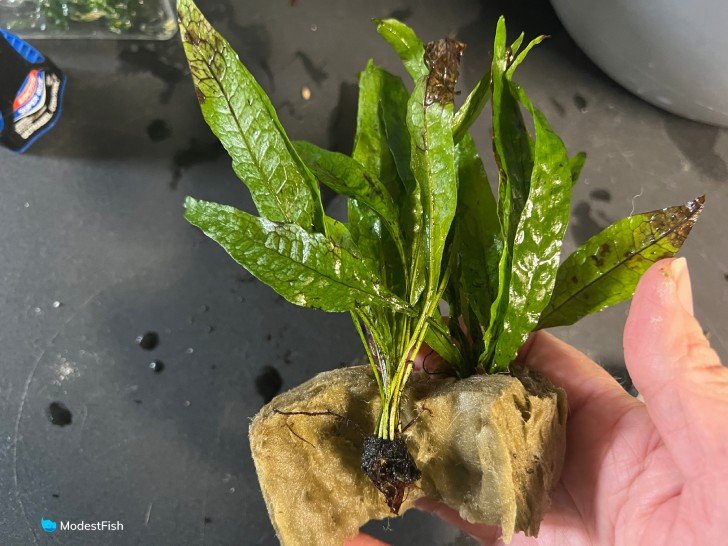
Planting and maintaining this Java fern is really easy. I just use regular super glue (pure cyanoacrylate) to attach it to a rock, piece of driftwood. The plant’s roots will stick to the surface on their own over time.
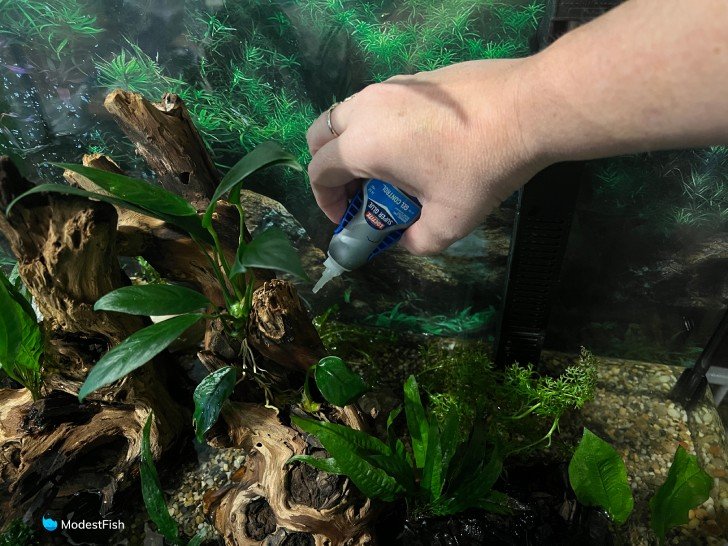
I love how its bright green leaves look in the tank; they are really pretty.
Java fern grows fairly slowly. I feel like this has pros and cons. It means that it doesn’t need frequent trimming, making it low maintenance, which I like, but it also means it does not eat up a lot of nitrate from the water column.
I get algae off of my Java fern leaves by gently rubbing them with my thumb, which will dislodge softer algae off the leaves.
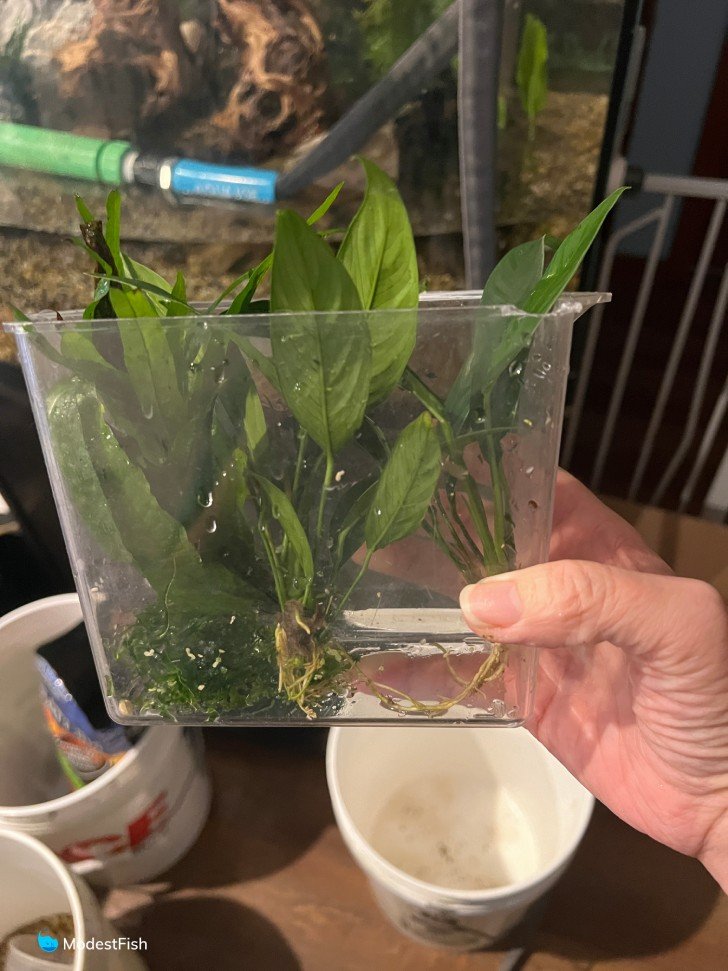
But, I’ve found Java fern can be very sensitive and melt back from algae treatments like peroxide, so if I need algae spot treatment, I only use Seachem Excel on it.
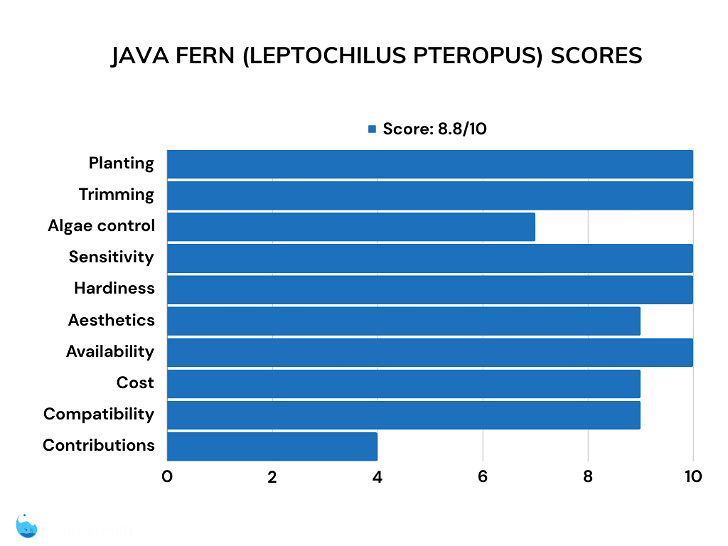
Pros:
- Easy to plant
- Extremely tough and versatile
- Bright green leaves
- Grows a bit faster than anubias
Cons:
- Grows slowly
- A bit harder to clean algae off leaves than anubias

Last update on 2024-04-09 / Commissions Earned / Images from Amazon Product Advertising API
2. Amazon Swords (Echinodorus grisebachii)
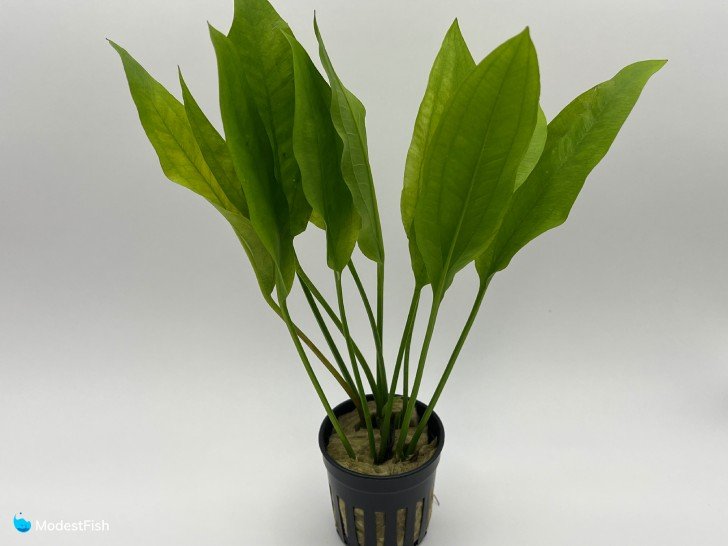
Verdict – classic and beautiful plant everyone should own at least once, but needs a large tank long-term.
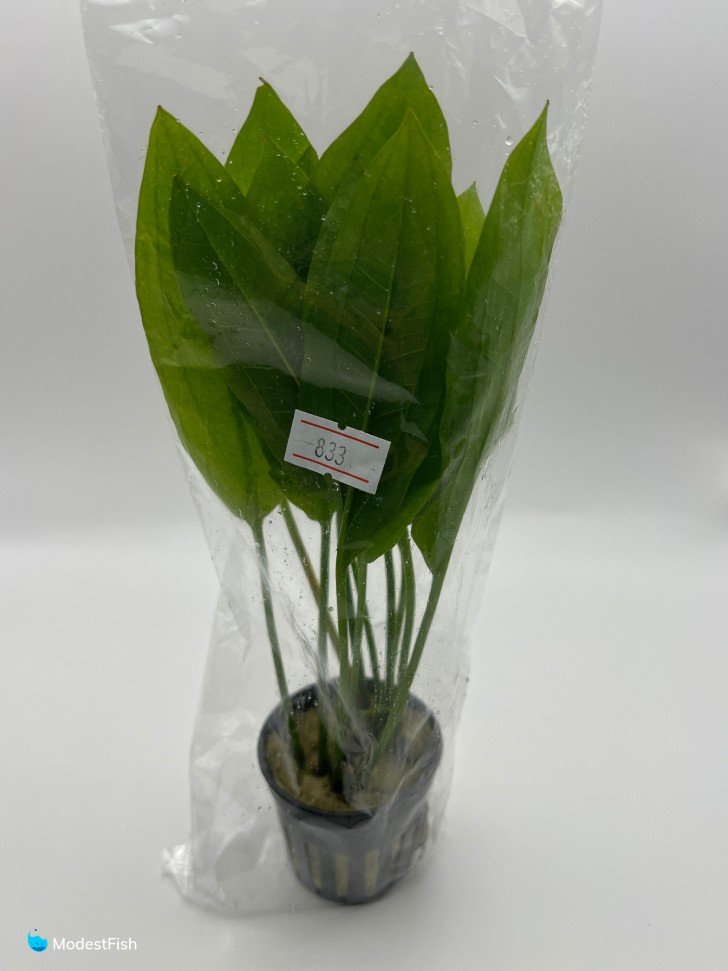

Love these! I have them in three different tanks.
But be warned! This plant gets very, very big. I wouldn’t even try to keep one of these in anything smaller than a 40 gallon (151 liter).
You’ll see lots of sources talk about how these plants are heavy root feeders and that you’ll need a fancy substrate or root tabs.
Honestly, I’ve grown huge Amazon swords in regular gravel and inert sand. In both cases, the tanks were fairly heavily stocked, so they fed off fish poop trapped in the substrate.

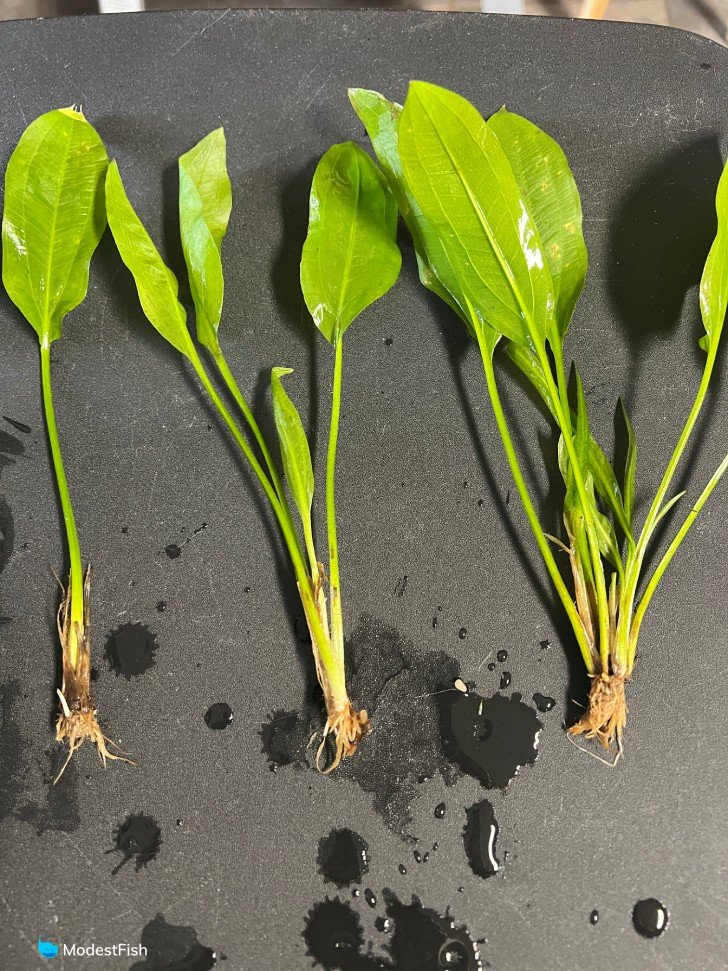
Not saying that a rich substrate is a bad thing for these plants, but I don’t think it’s absolutely necessary.
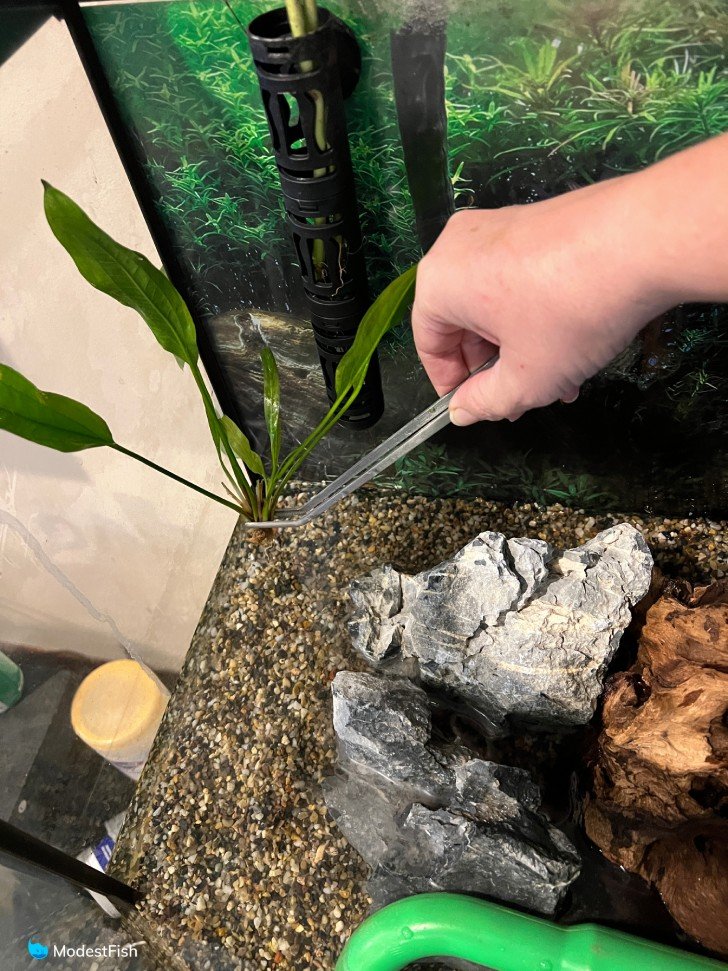
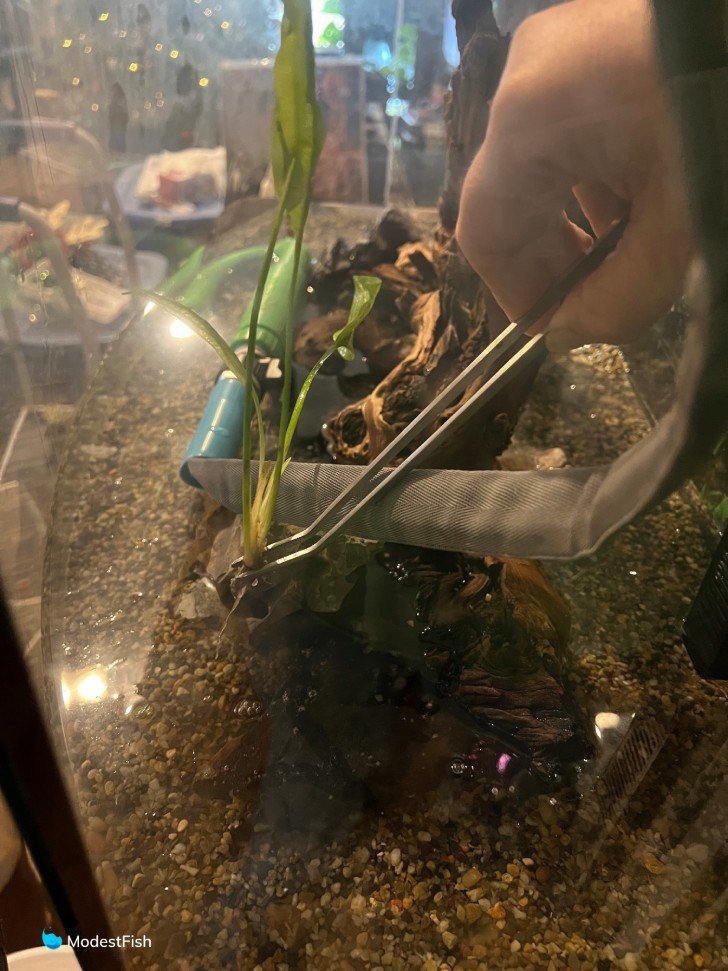
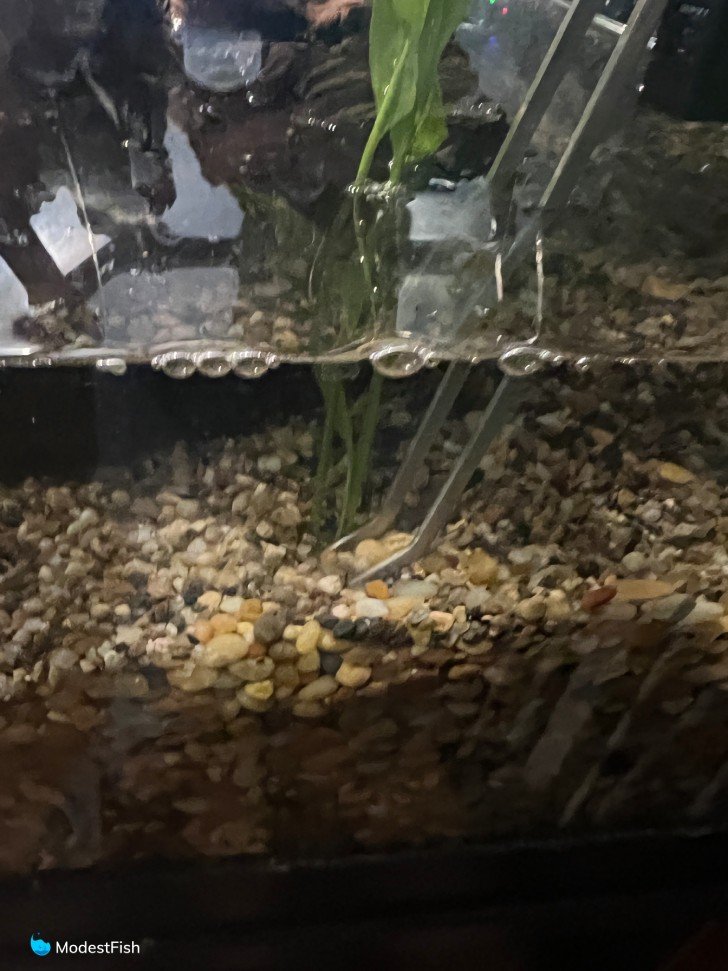
They’ve always done best for me under at least medium light.
I have found that their broad leaves do collect algae over time, but a little rubbing and some Seachem Excel can really help.
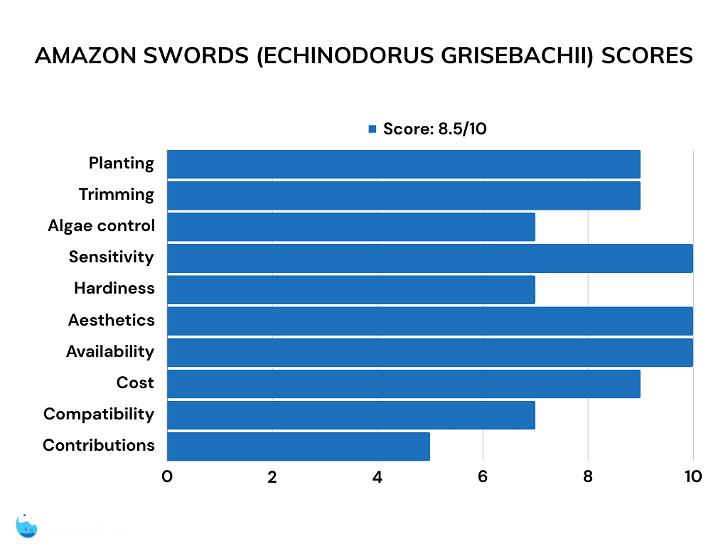
Pros:
- Beautiful
- Helps eat excess nutrients in the substrate.
- Provides good cover for small fish
- Low maintenance
Cons:
- Gets very large over time and can only be trimmed back so much

Last update on 2024-04-09 / Commissions Earned / Images from Amazon Product Advertising API
3. Anubias barteri
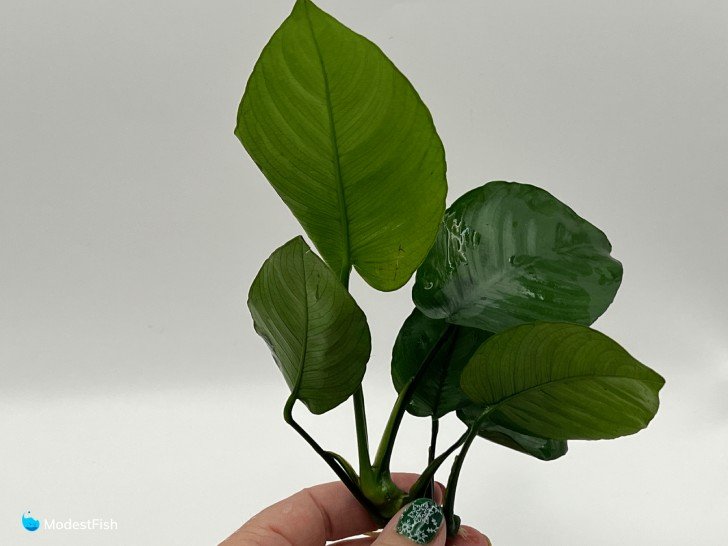
Verdict – my favorite of the smaller anubias varieties, a great beginner plant, with broad leaves that are simply gorgeous.
Anubias barteri is one of my all-time favorites. I’ve got it in three different tanks now.
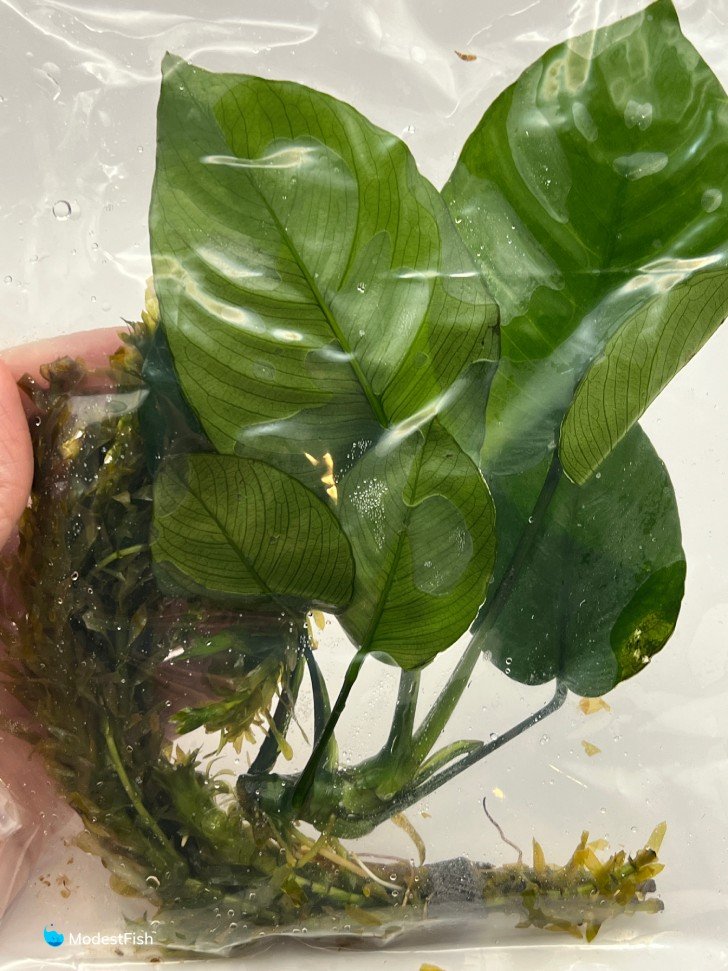
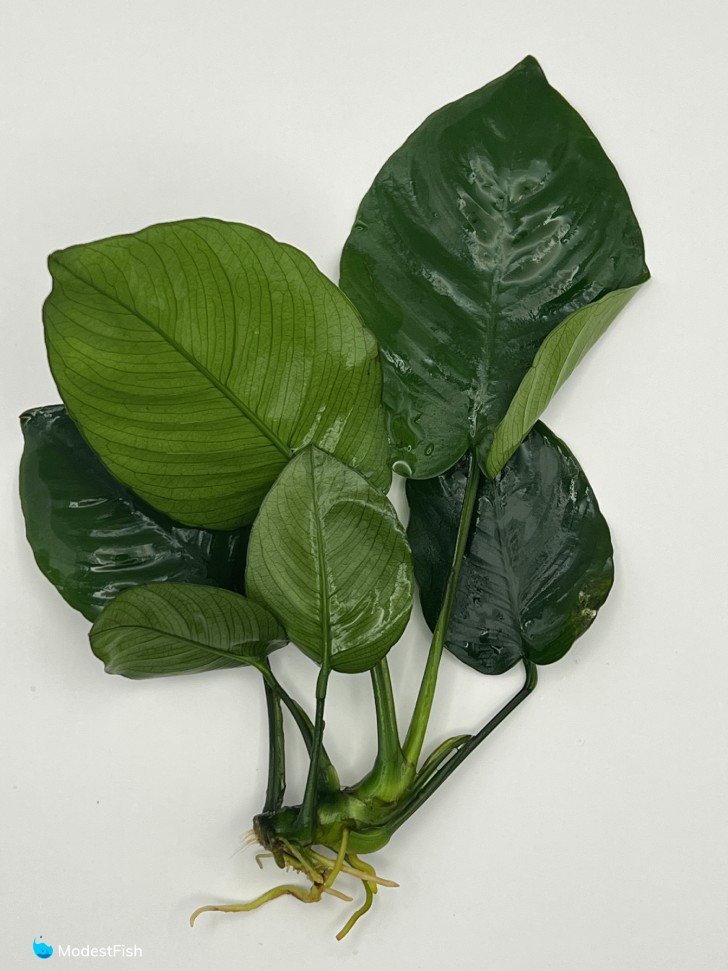
It’s another epiphyte that thrives on neglect. I’ve always found that it takes it a month or so to get established, but it will then grow slowly but steadily.
Algae does grow on the broad leaves, but I’ve found it relatively easy to wipe it or use Seachem Excel or peroxide to get it off.
I like that this species stays a sort of medium size. I use it as a background plant in small tanks and foreground plant in larger ones.
I haven’t noticed that this species makes a big difference in water parameters, but it really is a lovely addition to any tank.
Because it’s so tough, it can withstand many species of fish that eat plants, but really determined cichlids and Goldfish will still eat it.
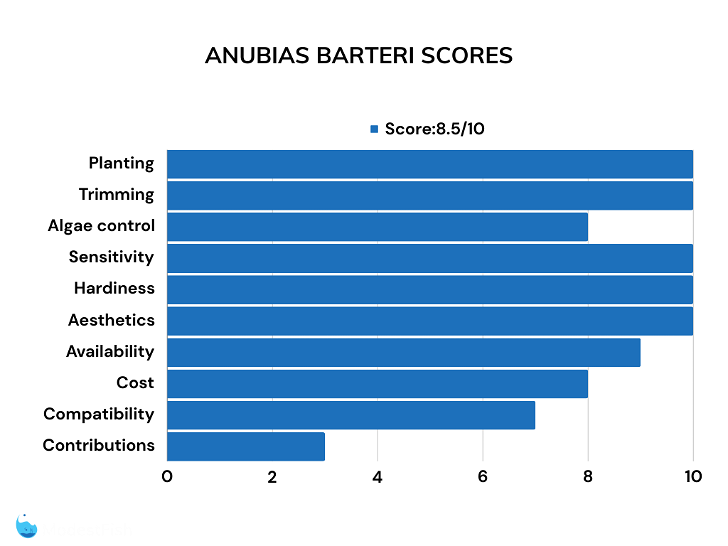
Pros:
- Beautiful broad leaves
- Medium size makes it great for large and small tanks
- Fairly easy to clean algae off
Cons:
- Slow to get established
- Slow growth rate
- Doesn’t eat much nitrate
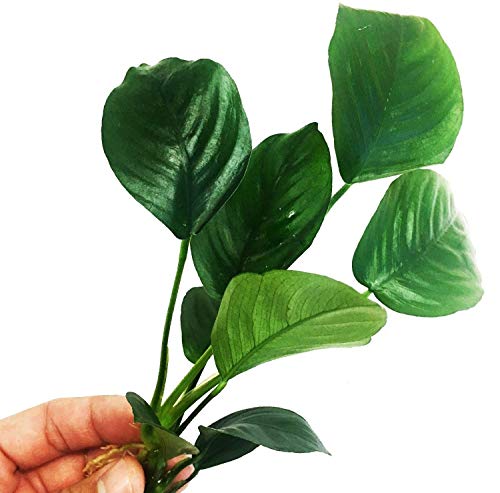
Last update on 2024-04-09 / Commissions Earned / Images from Amazon Product Advertising API
4. Anubias congensis
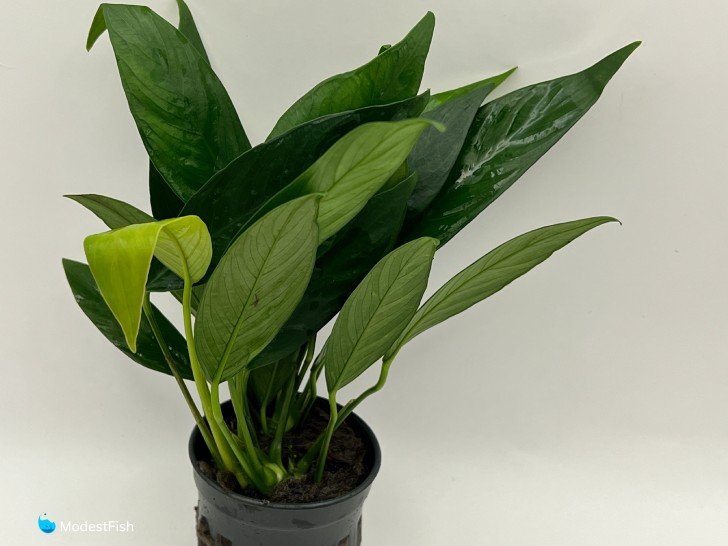
Verdict – this large anubias species can be a great centerpiece in a low light tank.
This is the largest species of anubias that I’ve ever owned. I know there are some larger ones out there, but I haven’t kept any and they’re very expensive and hard to find.
Anubias congensis, like other anubias, is slow to get established and grows slowly, but over time, its leaves can grow to be a foot long.


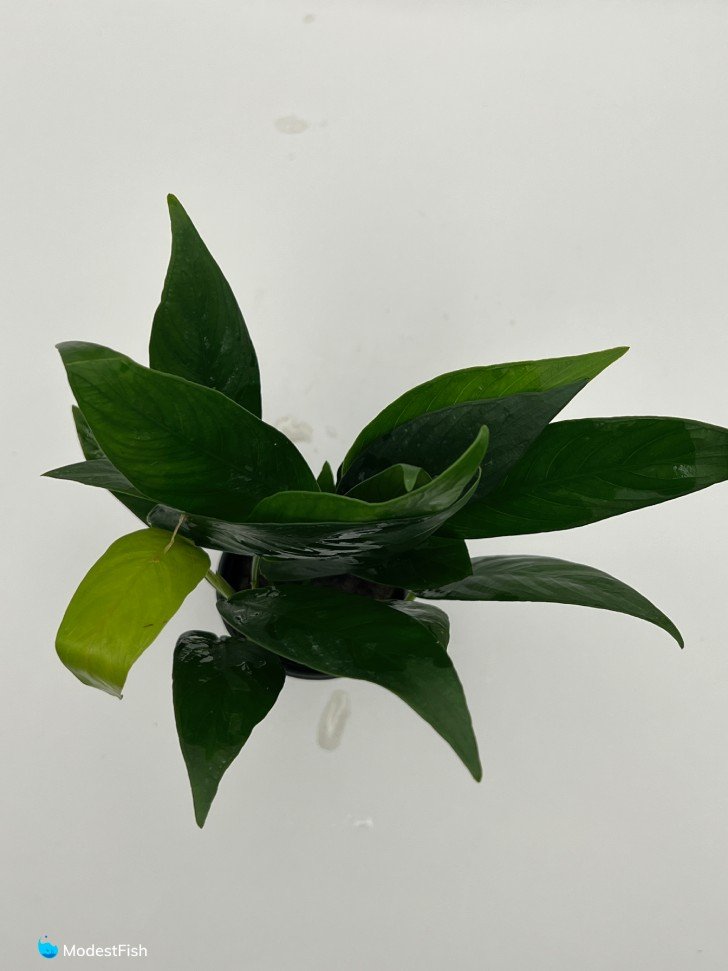
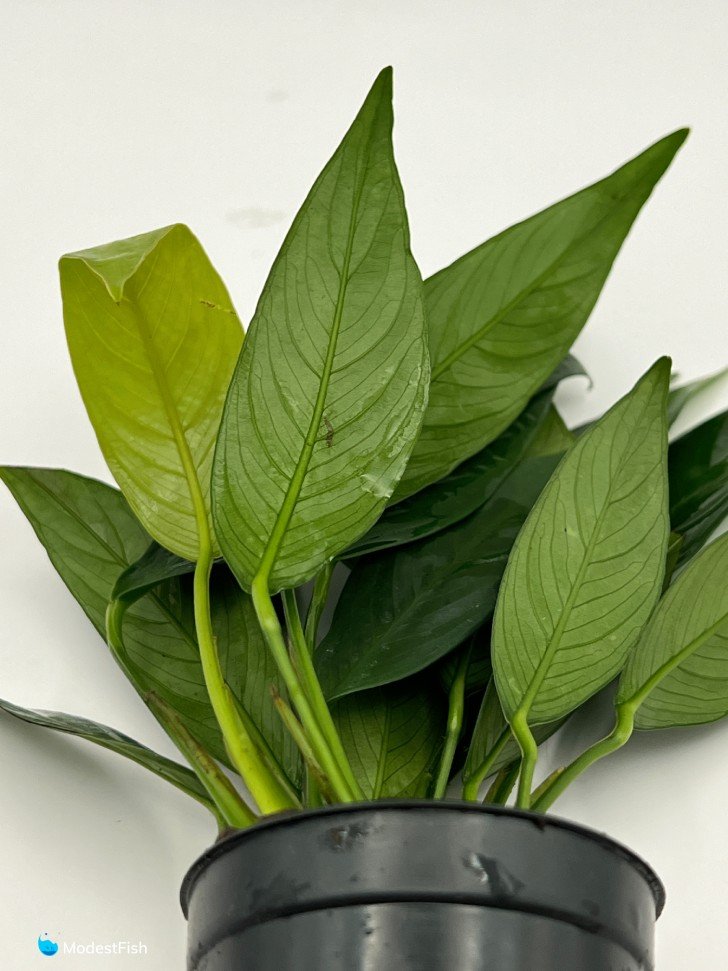
I have one that’s been in my red cherry shrimp tank for several years. It’s gotten so big that I have to trim cuttings off twice a year to keep it from getting completely out of control.
This plant isn’t fussy at all. I’ve always found it to be very tolerant of algae control measures, including rubbing algae off the leaves or spot treating with Seachem Excel and peroxide.
I’ve used this species as a background plant in small tanks or as a centerpiece in some larger tanks.
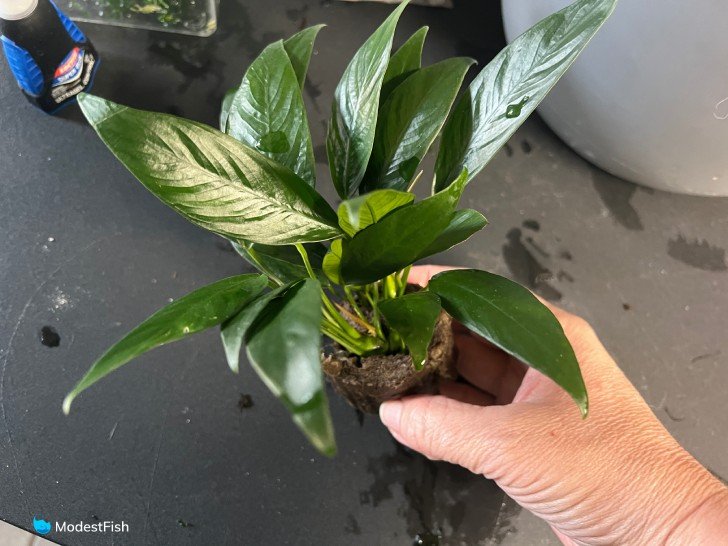
I just glue the rhizome to a rock or piece of driftwood. I then pretty much put it in the tank and leave it alone to do its own thing.
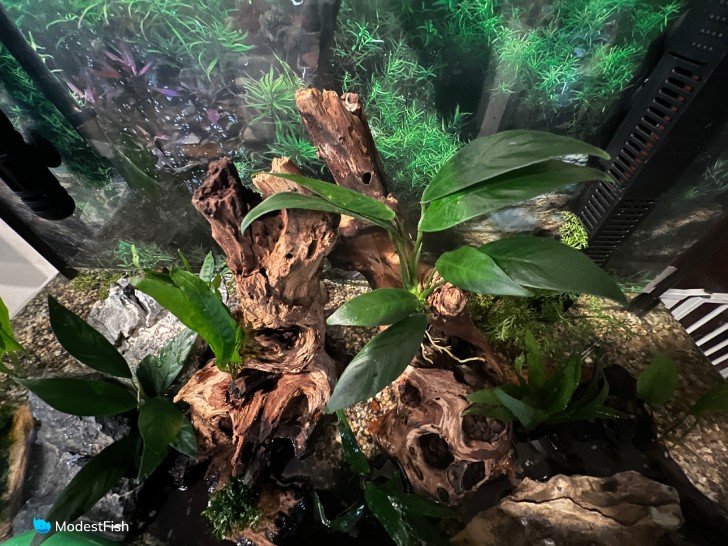
I’ve found that most fish won’t eat this species, but again, cichlids and Goldfish will eat just about anything.
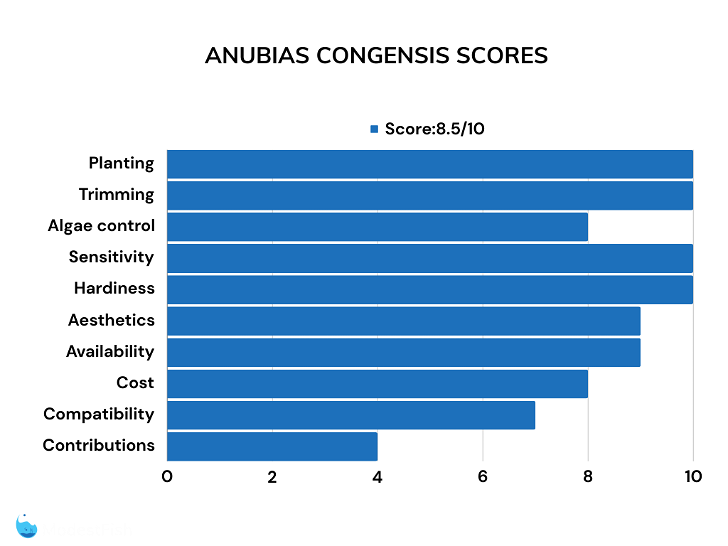
Pros:
- Easy to plant and maintain
- Larger anubias that really stands out
- Beautiful, long, pointed leaves
- Easy to clean off algae
Cons:
- Slow to get established
- Slow growth rate
- Doesn’t eat up much nitrate

Last update on 2024-04-09 / Commissions Earned / Images from Amazon Product Advertising API
5. Anubias nana
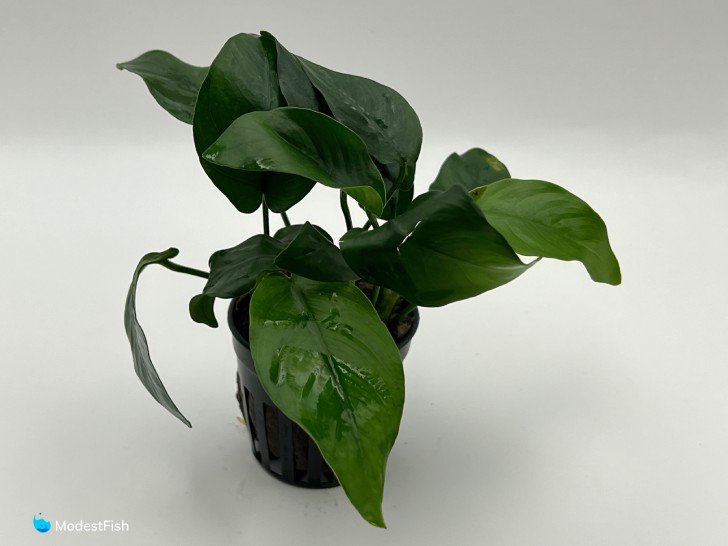
Verdict – this dwarf species of anubias is super cute and perfect for smaller setups.
I use Anubias nana in smaller tanks, like 20 gallons (76 liters) or less. Mine has always been quite small, it likes to creep along the substrate, forming a long rhizome with tiny leaves.
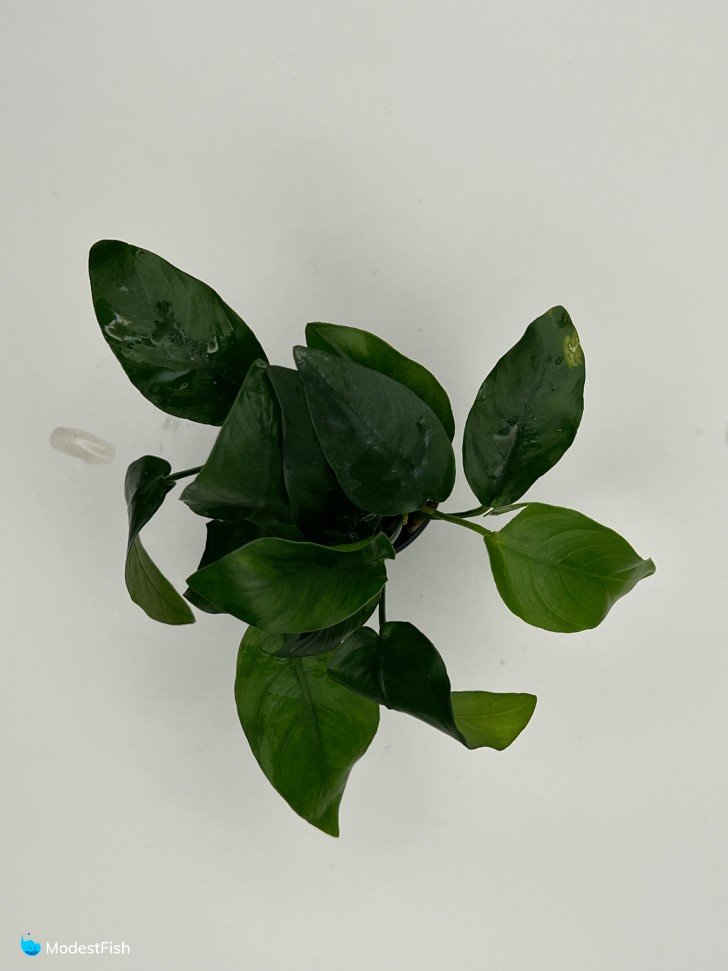
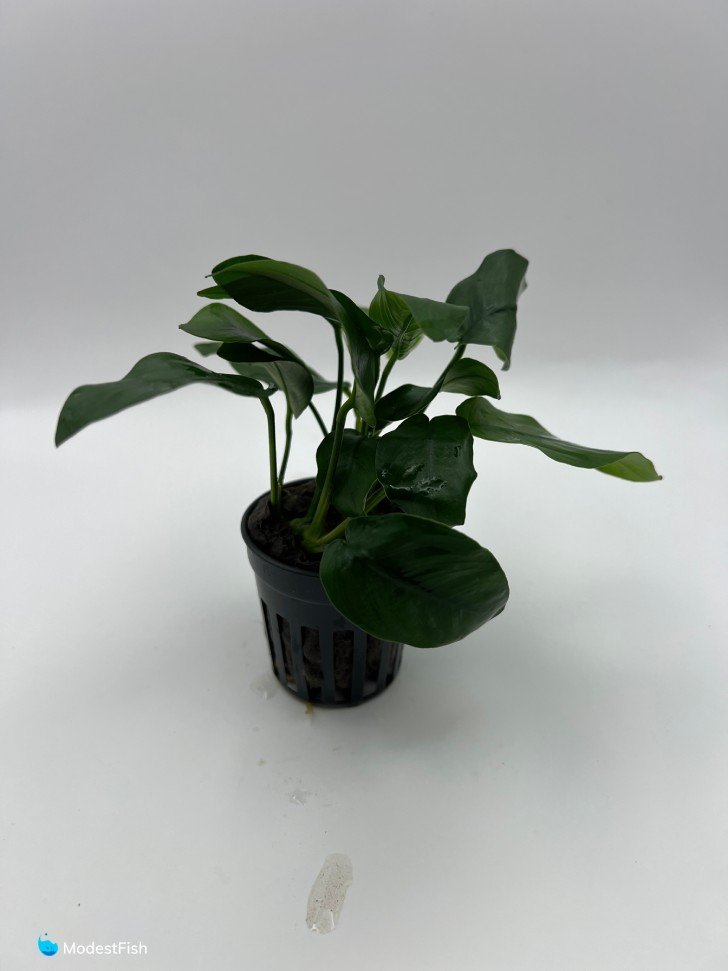
I’ve lost some over the years because this species can easily get choked out by larger plant species. I recommend keeping it towards the front of the tank or attached to hardscape elements that keep it higher up and out from under larger plants.
I’ve found it easy to clean algae off this plant’s leaves and it’s tolerant of spot treatment with Seachem Excel.
This is another species that you can mostly just plant and leave it to its own devices.
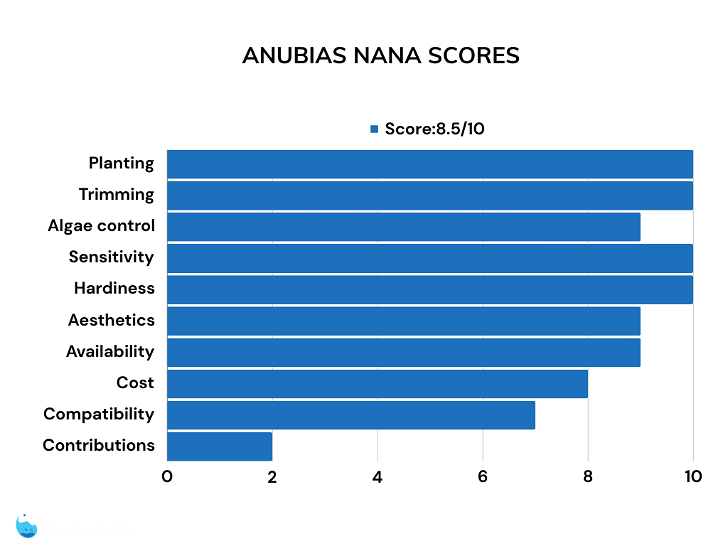
Pros:
- Perfect dwarf plant for small tanks
- Easy to plant and needs almost no trimming
- Thrives on neglect
- Great no maintenance foreground plant
Cons:
- Easily overshadowed by larger plants
- Grows slowly
- Doesn’t eat up much nitrate

Last update on 2024-04-10 / Commissions Earned / Images from Amazon Product Advertising API
6. Water Sprite
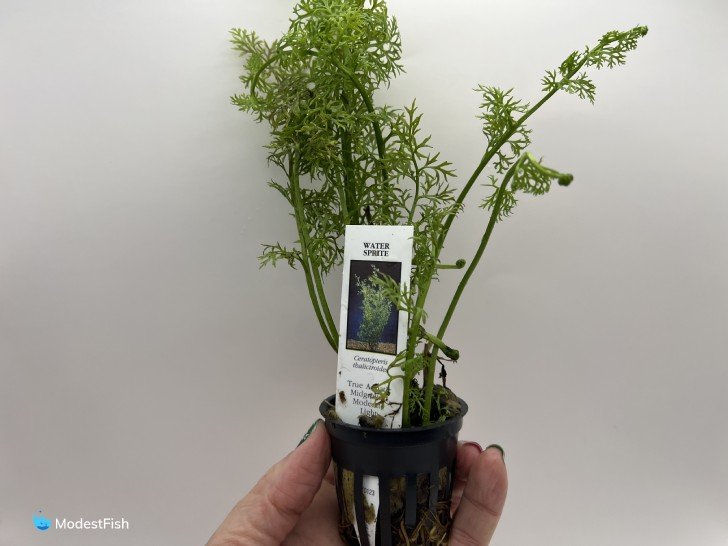
Verdict – this fast growing stem plant is great for reducing nitrate in the water column, but does need frequent trimming and replanting.
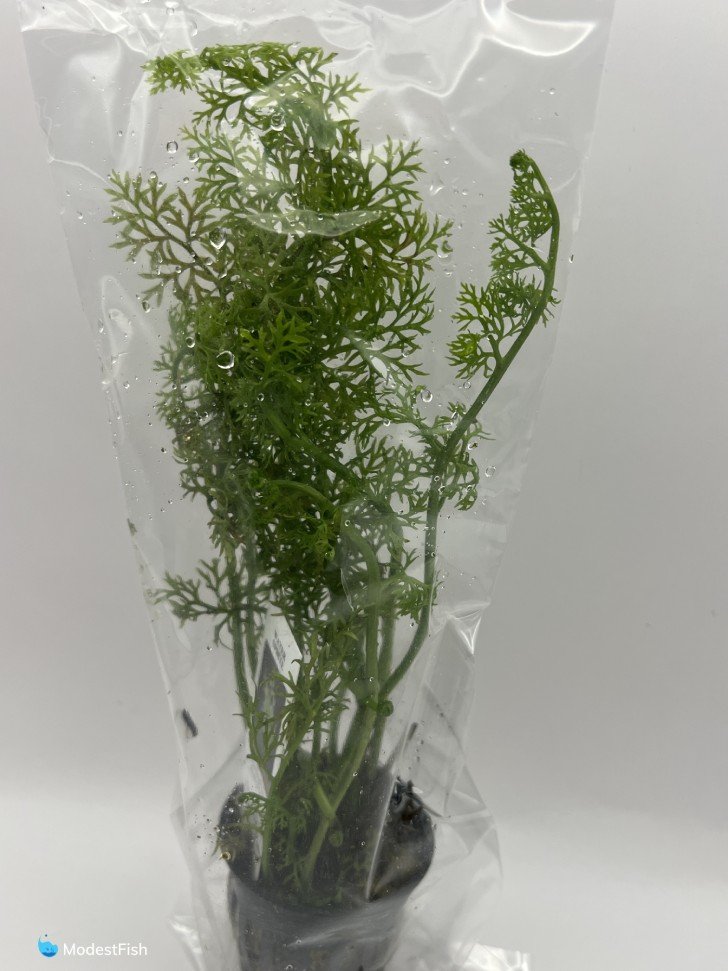
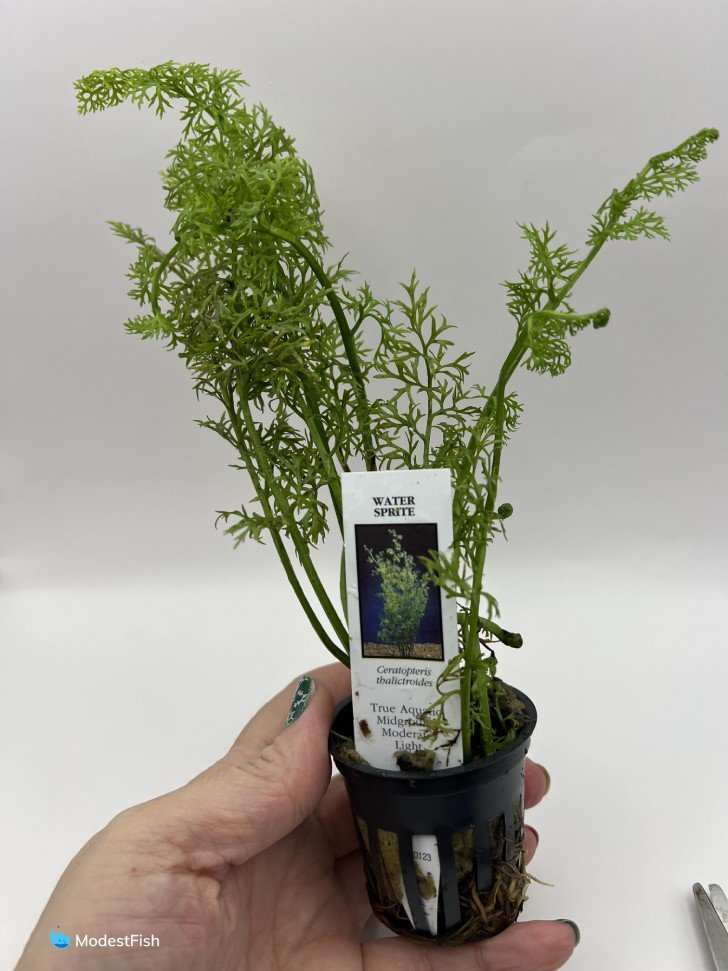

Water sprite is a nifty plant that grows very, very quickly.
I’ve always used it as a background plant since it grows toward the top of the tank so fast.
I have definitely noticed that it has a positive influence on water parameters. It eats up quite a bit of nitrate.
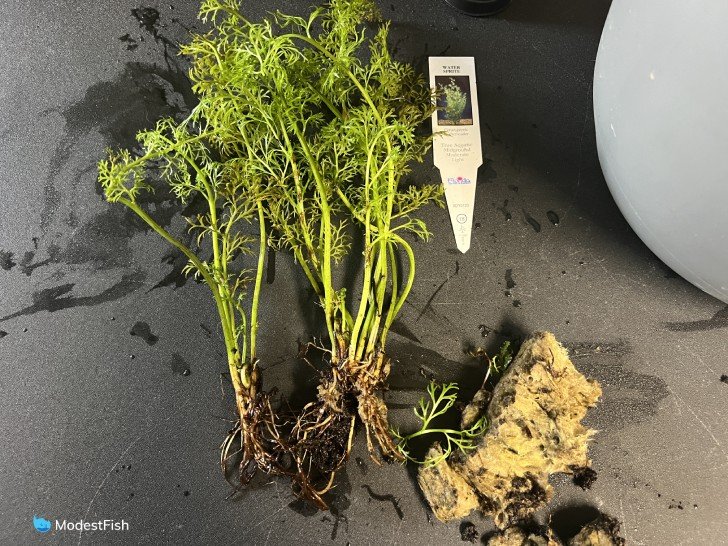
It can be a bit of pain to plant this and get it to stay put. I bury quite a bit of the stem, at least several inches, to keep the plant from floating off. I also sometimes place rocks around the base of the cuttings to help weigh them down.
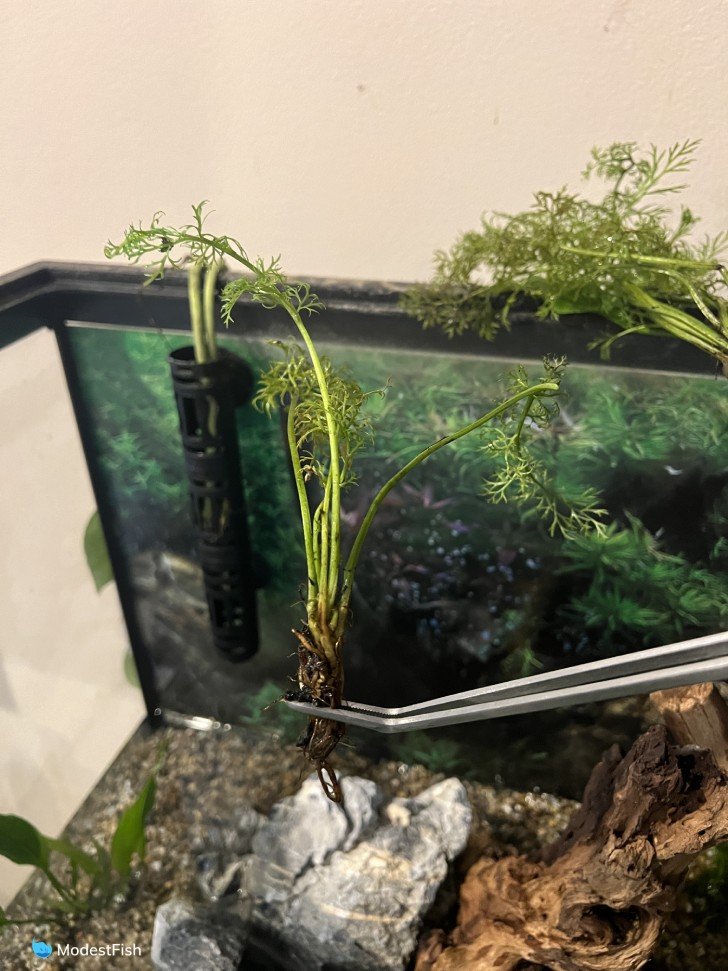

The only thing that I don’t like about this plant is that it grows so fast, I have to frequently trim it back. But, you can chop off the tops of the plants and then bury them in the substrate to form new plants.
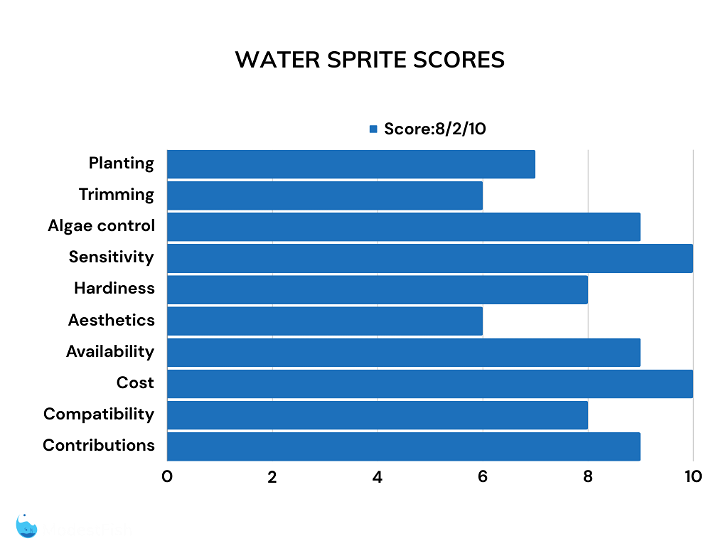
Pros:
- Fast growing plant that eats up nitrate
- Easy to propagate from cuttings
Cons:
- A bit of a pain to plant
- Requires frequent trimming

Last update on 2024-04-09 / Commissions Earned / Images from Amazon Product Advertising API
7. Brazilian pennywort (Hydrocotyle leucocephala)
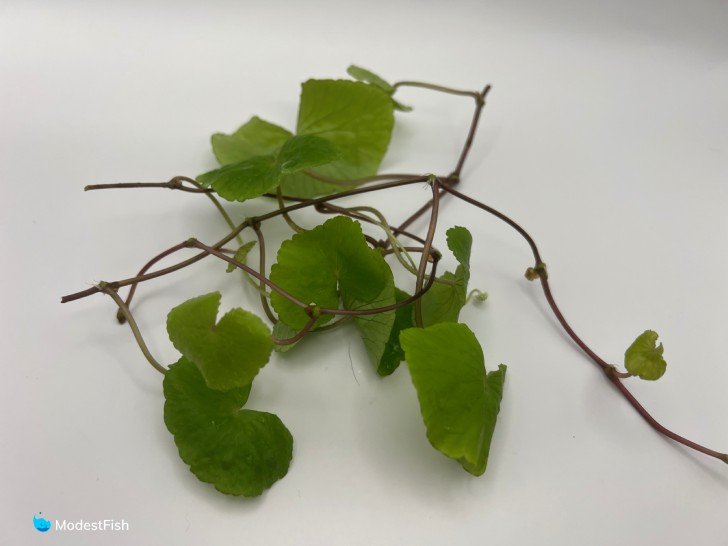
Verdict – awesome floating plant that eats up nitrate directly from the water column and looks like a string of tiny lily pads.
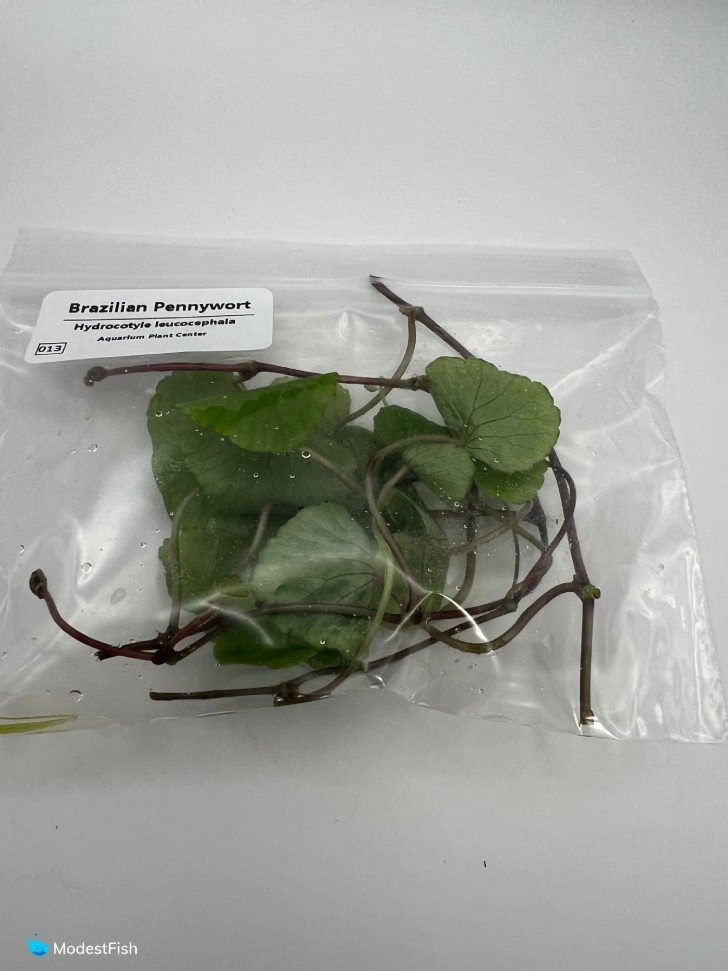
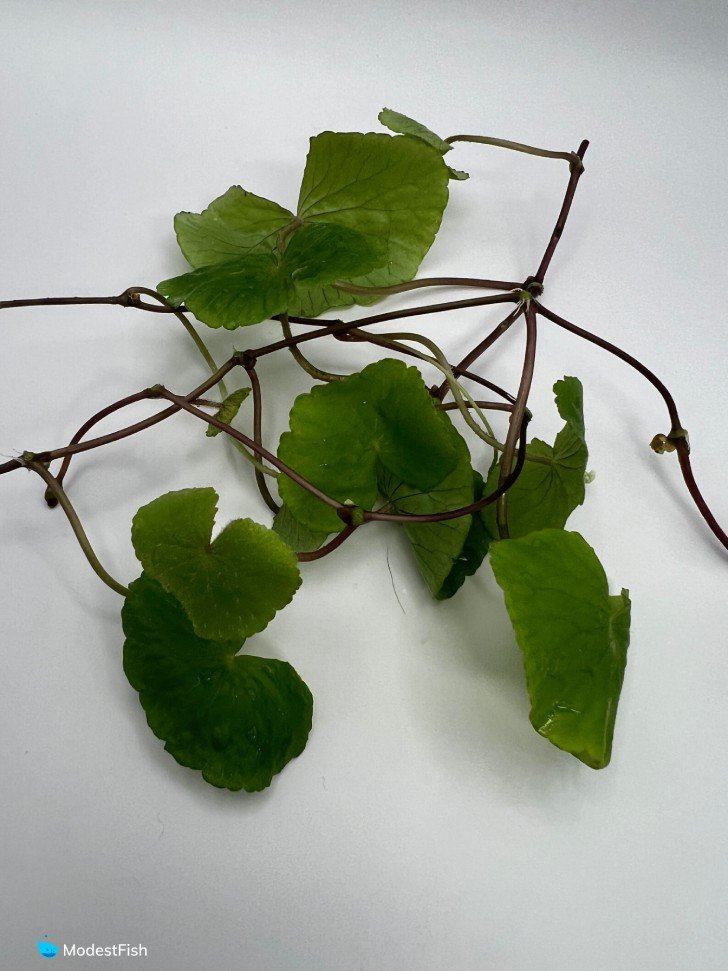
I love this plant so much. I’ve kept it for years. It grows as a long, skinny, vine-like stem that sprouts leaves every few inches. When the leaves float at the surface, they look like a string of miniature lily pads. A cluster of roots trails down into the water below each leaf.
It can really spread, so I recommend keeping it in at least a 40 gallon (151 liter).
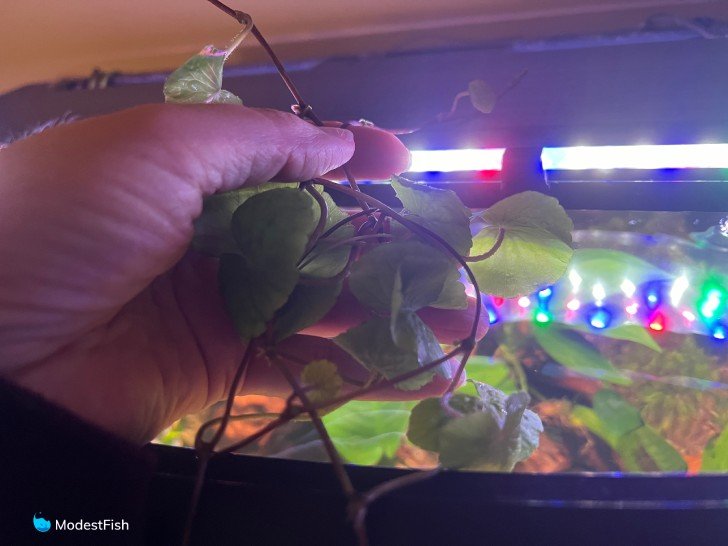
I’ve found that it does need to be dosed with a micronutrient fertilizer, like Seachem Flourish, for it to really take off. And I’ve also noticed that it goes through a dormant period for a month or two each year. But then, after its little break, it then starts growing again like crazy.
You will need to trim it fairly regularly, just don’t cut it back too much because it won’t grow during its dormant period.
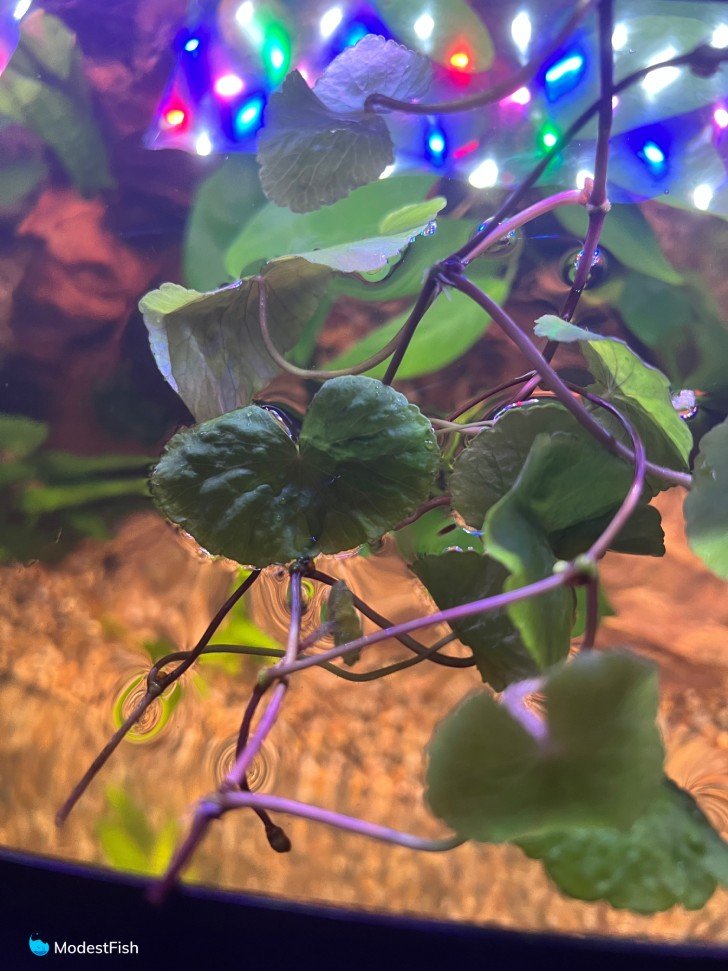
Some sources will say that it can be rooted down in the substrate, and it can be, but I’ve found that it’s a major pain in the butt to do this. It doesn’t really root and anchor itself. It will break off and float back to the surface every chance it gets.
Just let it float! I anchor mine in place at the water’s surface, with feeding rings or veggie clips, and let it grow along the surface of the top of the tank.

Pros:
- Grows quickly
- Shades plants below, reducing algae
- Looks like miniature lily pads
- Eats up lots of nitrate during its growth period
Cons:
- Requires somewhat regular trimming
- Goes through dormant periods where it doesn’t grow much

Last update on 2024-04-09 / Commissions Earned / Images from Amazon Product Advertising API
8. Java Moss (Taxiphyllum barbieri)
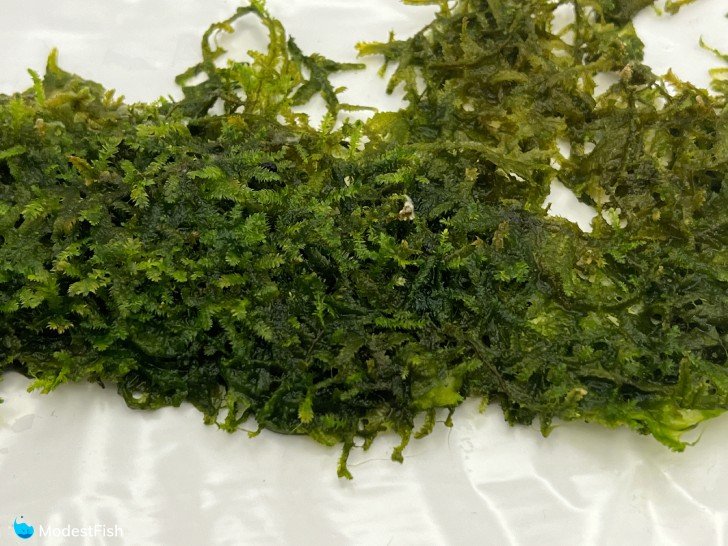
Verdict – this plant grows in a crazy quirky tangle that is an excellent habitat for shrimp and baby fish.
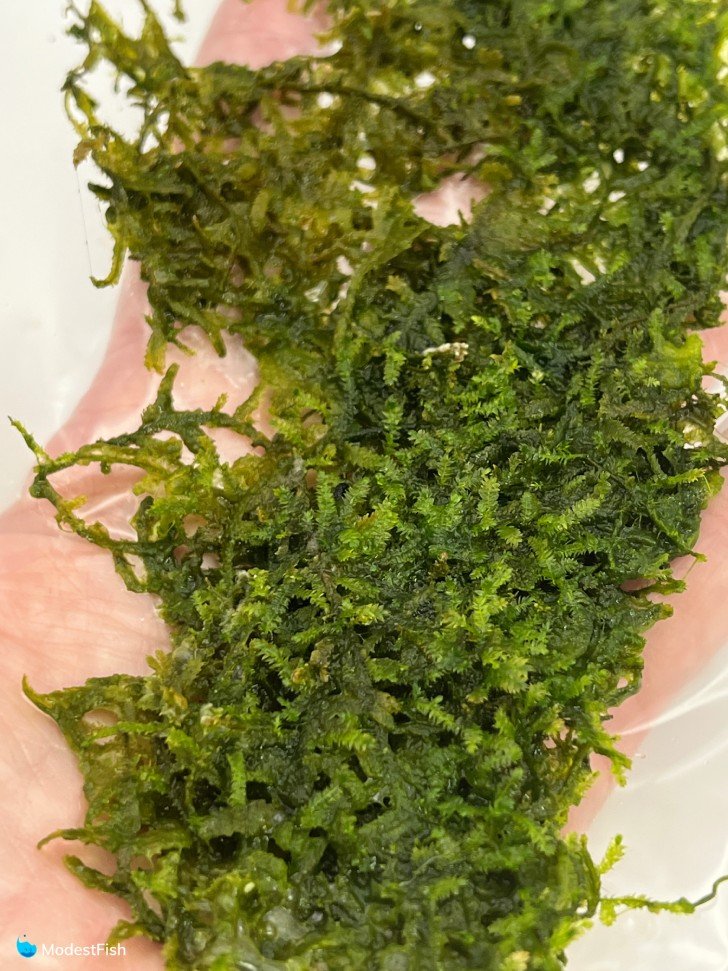
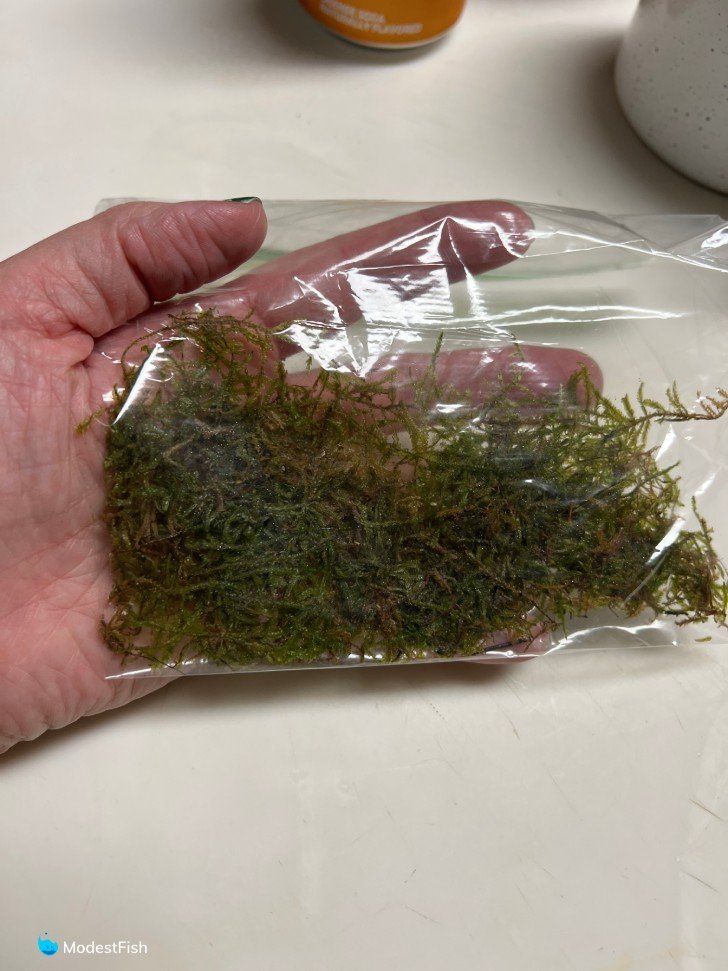
Java moss is probably the easiest aquarium moss to grow. I keep a big clump of it growing in one of my angelfish tanks.
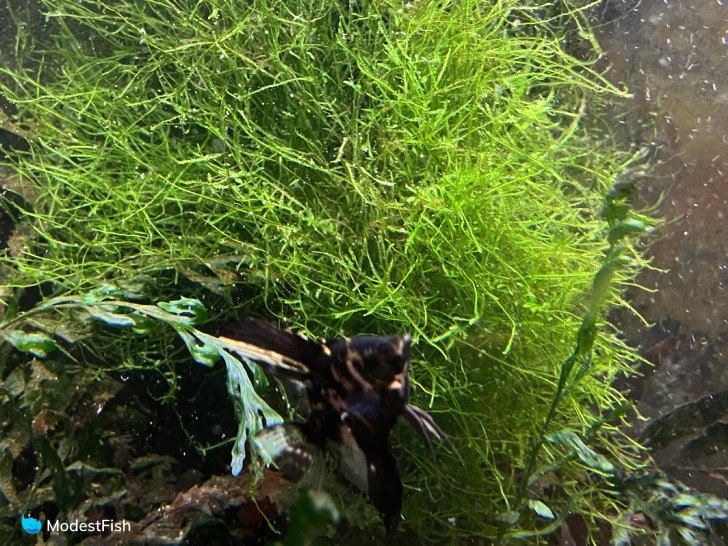
It puts out thin, twiggy fronds that grow in an irregular pattern. To me it always looks like a head of messy green hair. At first, I didn’t like the look of Java moss, but now it’s really grown on me.
It’s not as pretty as flame moss or Christmas moss, but it’s much more tolerant of low light conditions than the other two, in my experience.
I’ve found that it’s really easy to plant. I just super glue clumps of it onto rocks or driftwood. The moss puts out little sticky “feet,” root-like structures that anchor it in place as it grows.
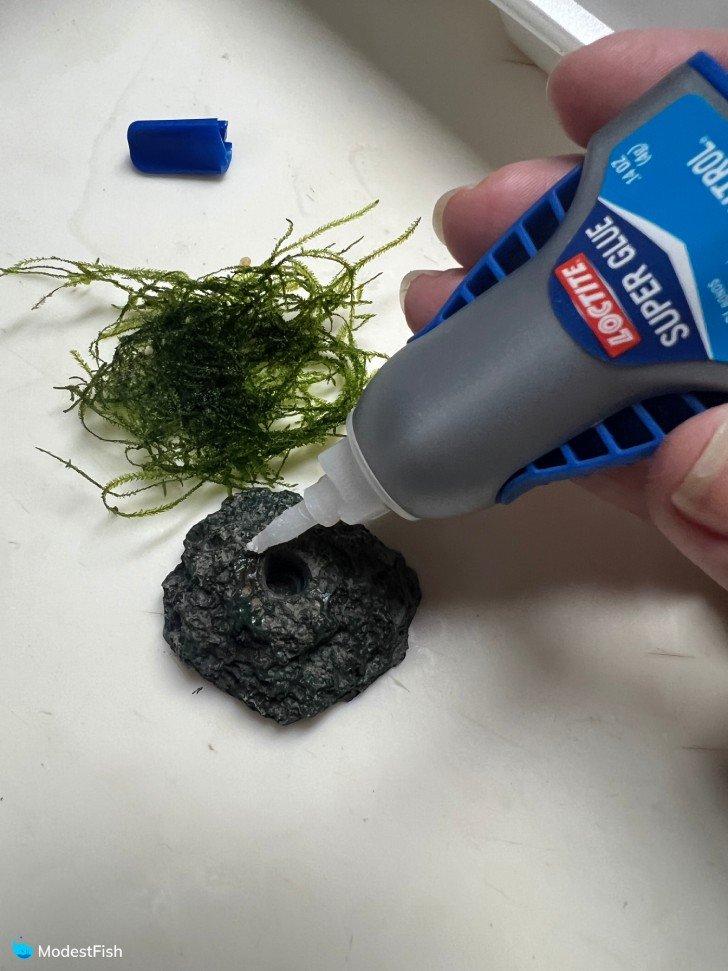
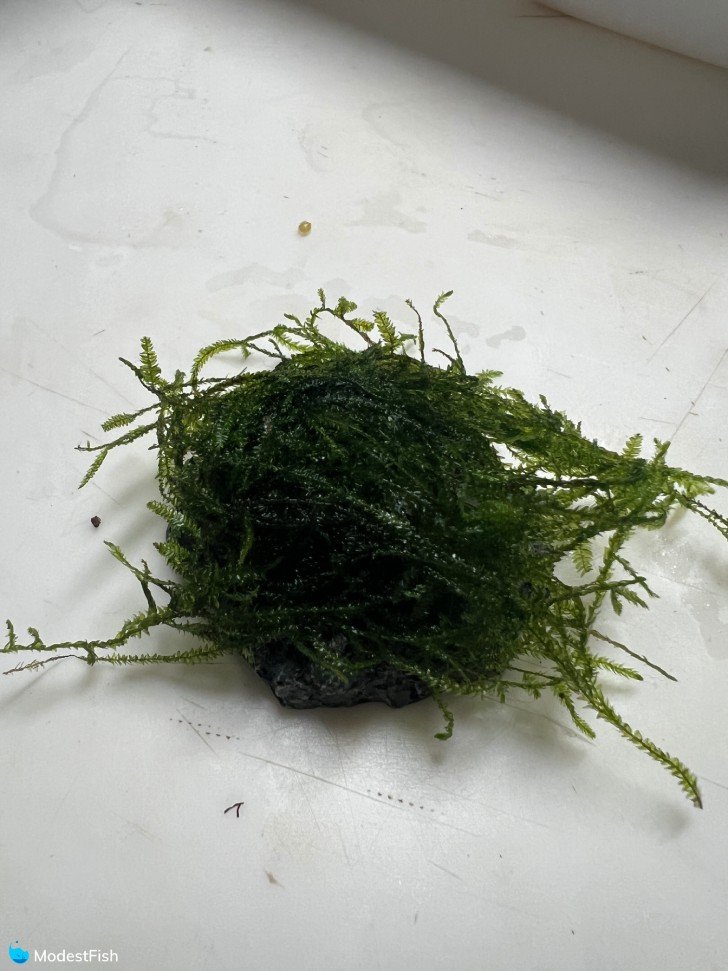
In my experience, with halfway decent lighting, a small ball of Java moss can turn into a large, unruly mass within 6 months.
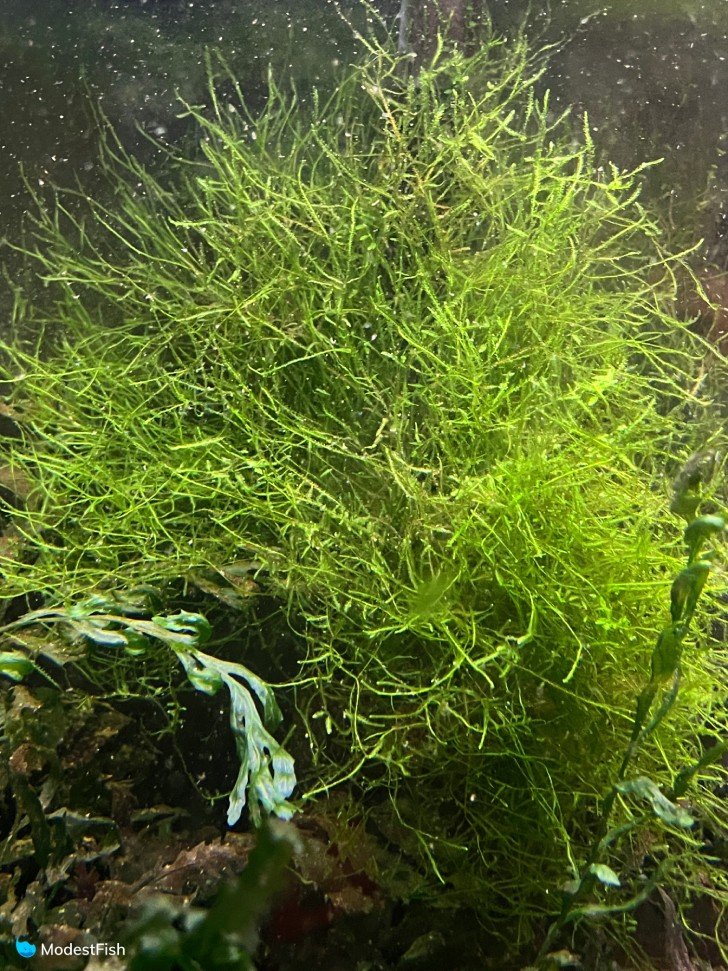
If the messy look bothers you, you can simply shape up the moss with some scissors every month or so.
My shrimp have always loved to hide and feed in this moss. It makes for great cover and feeding ground for shrimplets.
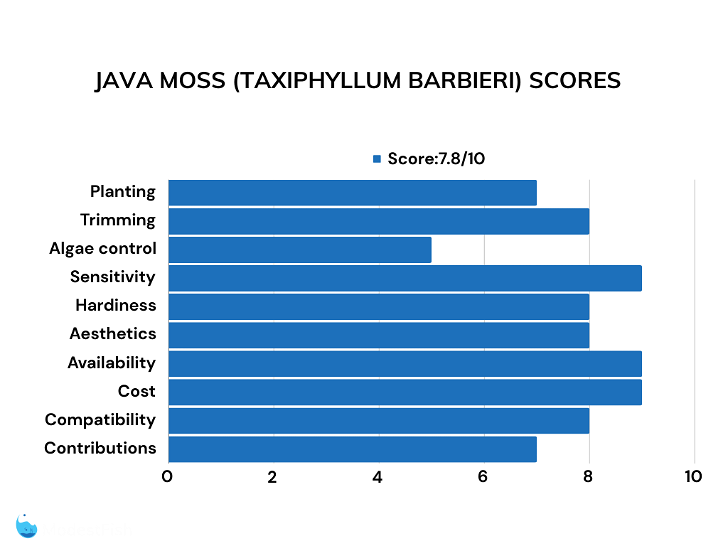
Pros:
- Easy to plant and maintain
- Excellent cover for fry and shrimplets
- Grows quickly
- Tolerates low light
Cons:
- Messy appearance if left untrimmed

Last update on 2024-04-09 / Commissions Earned / Images from Amazon Product Advertising API
9. Cryptocoryne wendtii
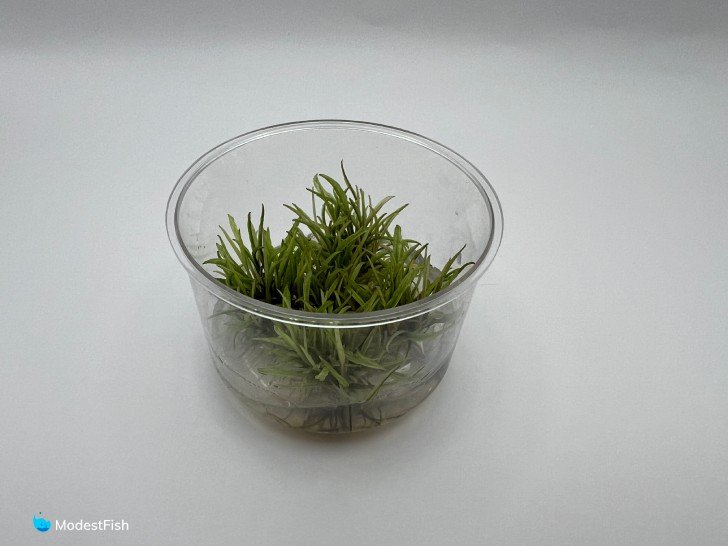
Verdict – this small crypt is a great foreground plant for smaller tanks, but it is very sensitive to large swings in parameters.
I think this species of crypt is such a cute little foreground plant. I’ve had it growing in my blue velvet shrimp tank for quite some time now. Its small size makes it perfect for that 5 gallon (19 liter) tank.
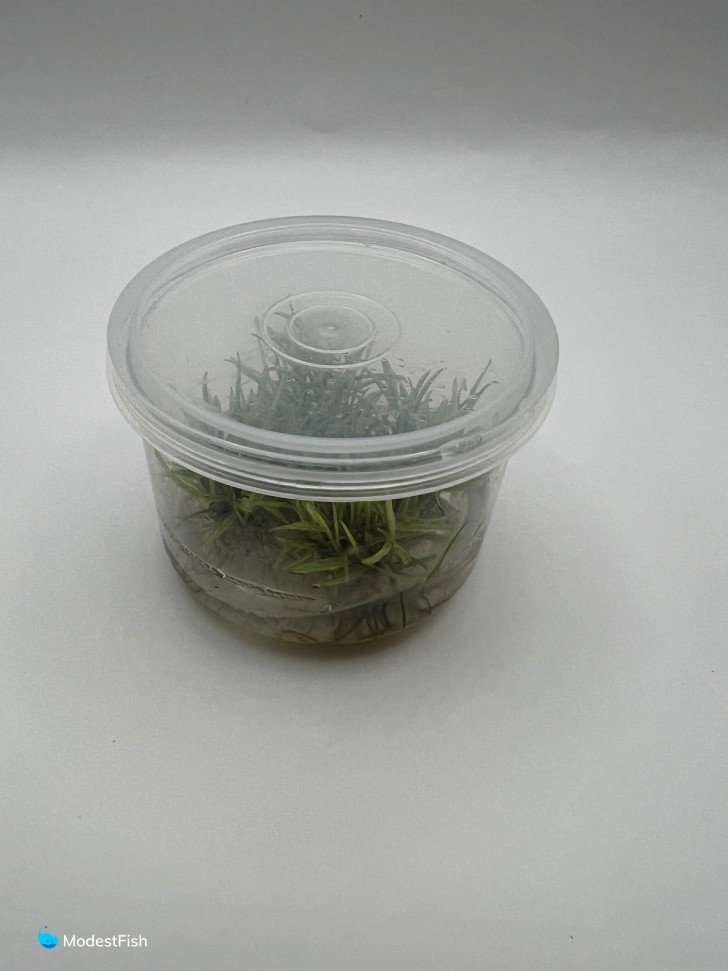
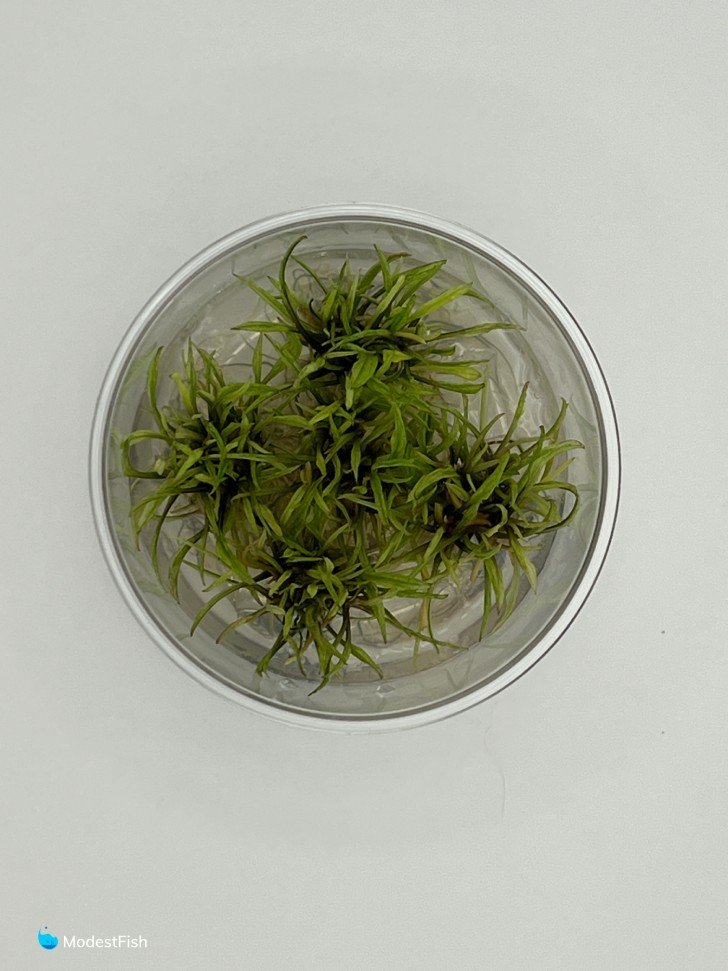
It forms a messy little jungle that the shrimp love to explore. Even in that small of a tank, these plants look proportionate.
In my experience, they can tolerate very low light conditions, growing under lighting that would kill other plants, even other crypts.
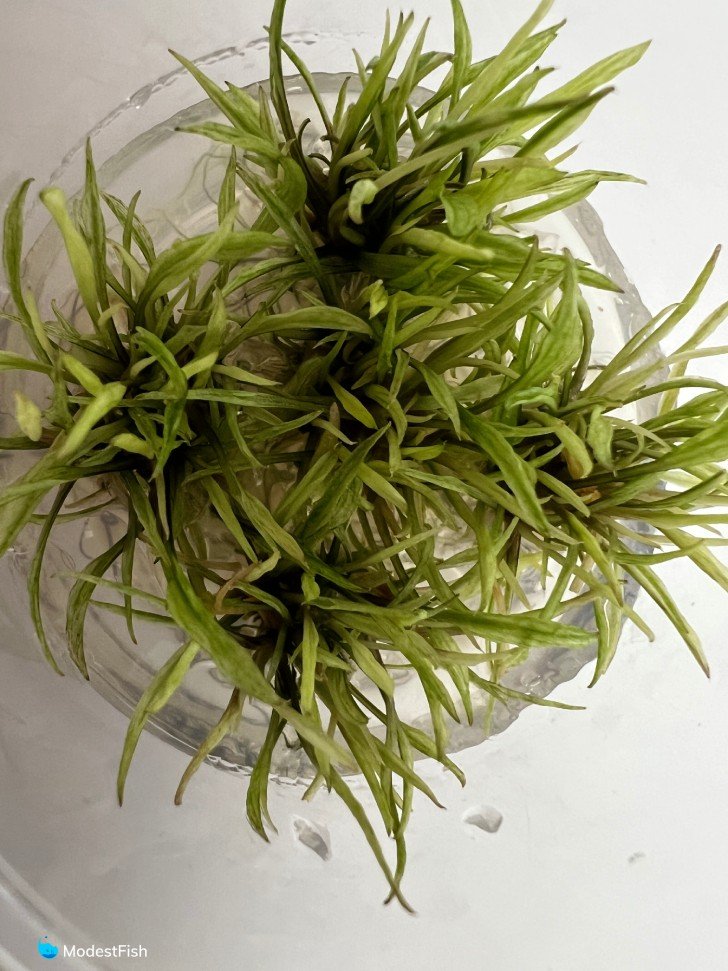
I have found that it does need a nutrient rich substrate to grow in. This plant feeds heavily from its roots. I haven’t been able to get it to grow in a gravel tank at all.
I have found it to be very sensitive. Significant changes in GH and pH can cause it to melt back and lose all of its leaves quite suddenly.
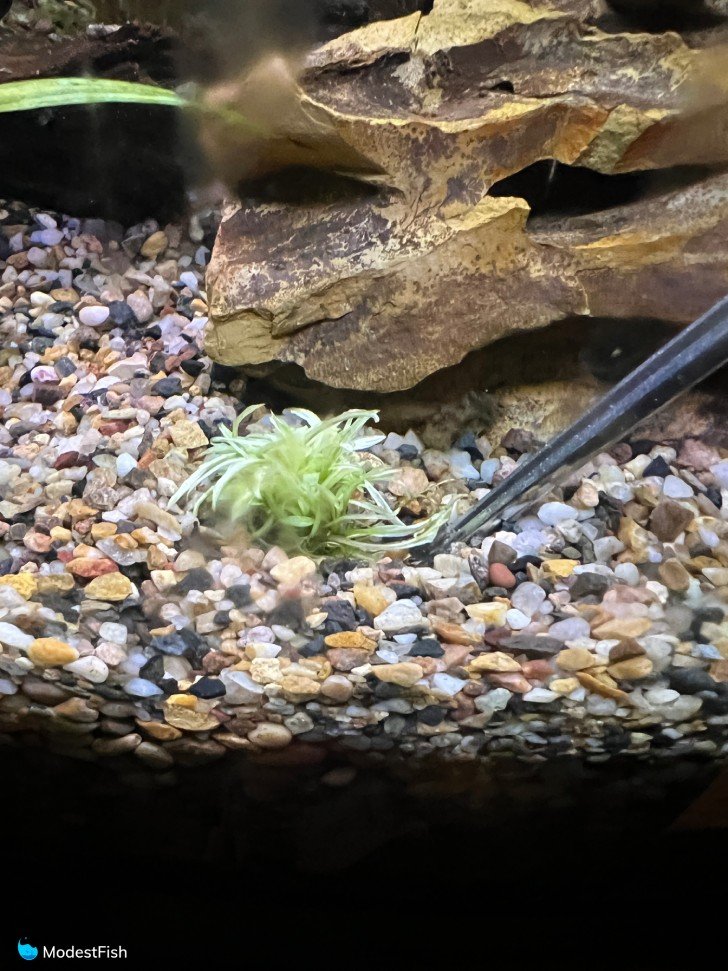
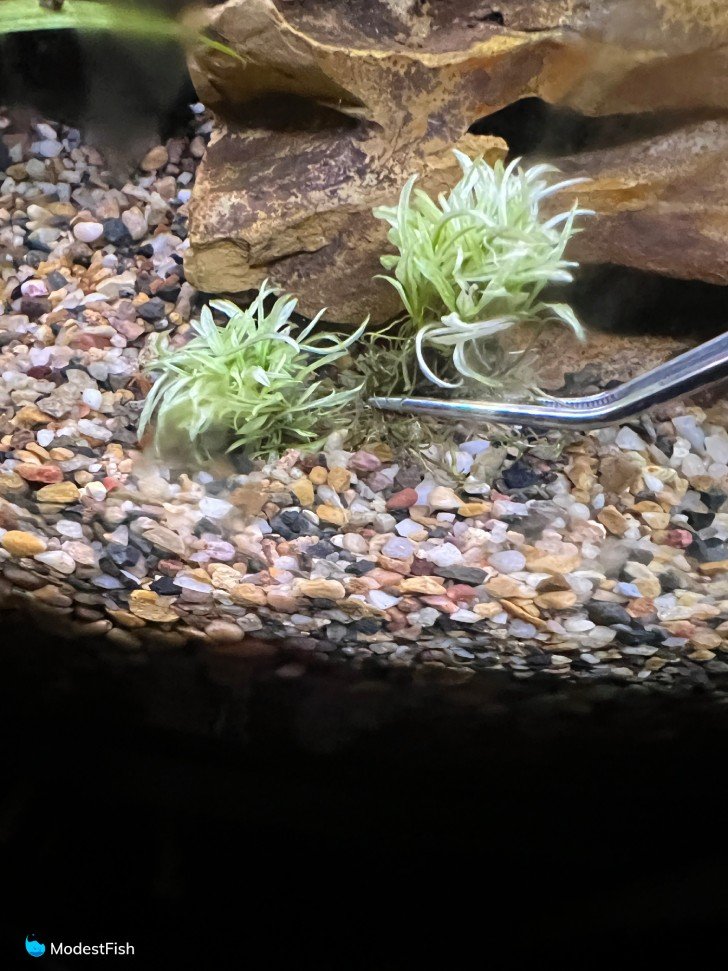
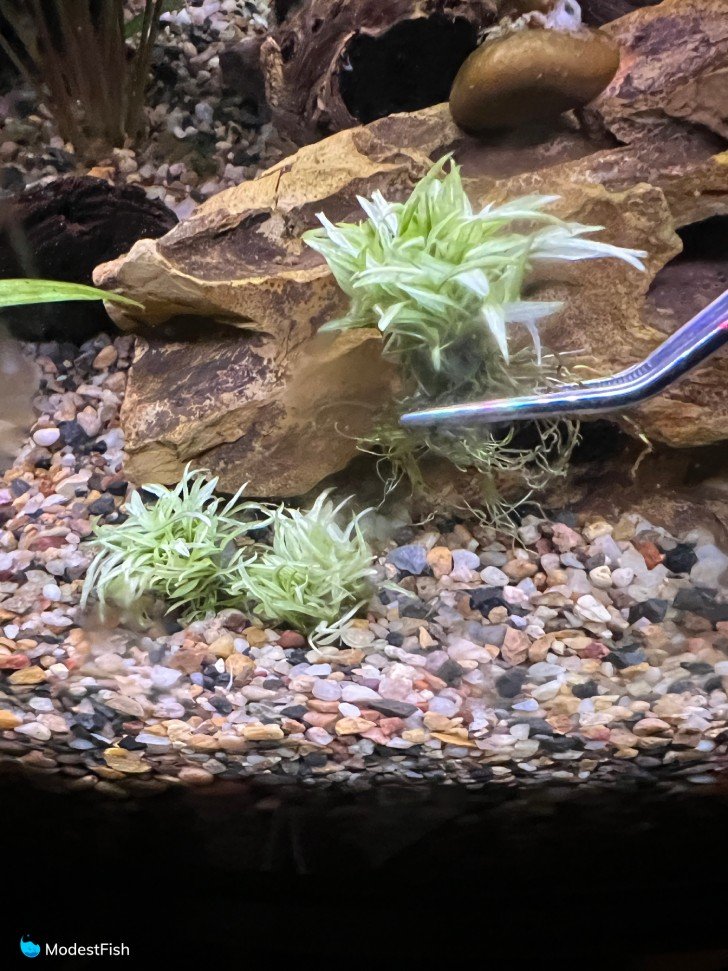
Mine was absolutely beautiful, doing great, then I had to do a series of somewhat large water changes, and all of my Crypt wendtii melted back to nothing but roots over the next week. I was so upset.
All of the plants did bounce back and start putting out new leaves, but it took a few months for it to go back to the jungle it was before.
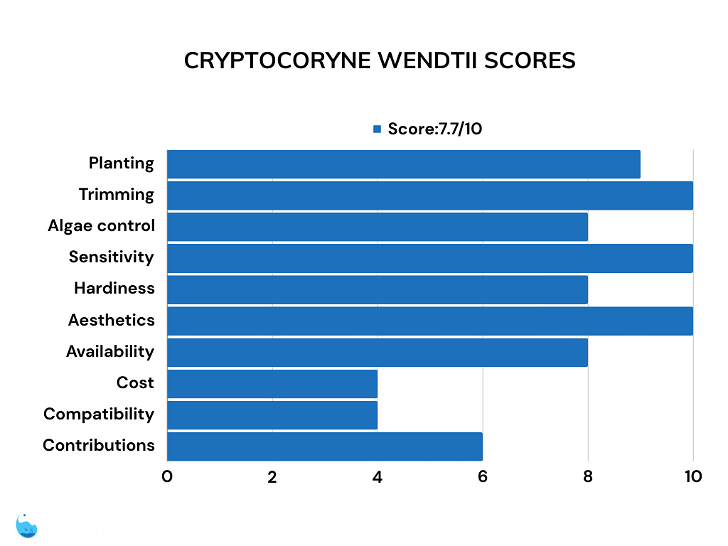
Pros:
- Perfect foreground plant for small tanks
- Very tolerant of low light conditions
- Will spread over the substrate through runners
- Provides excellent cover for shrimp
Cons:
- Needs a nutrient rich substrate
- Very sensitive to changes in water parameters
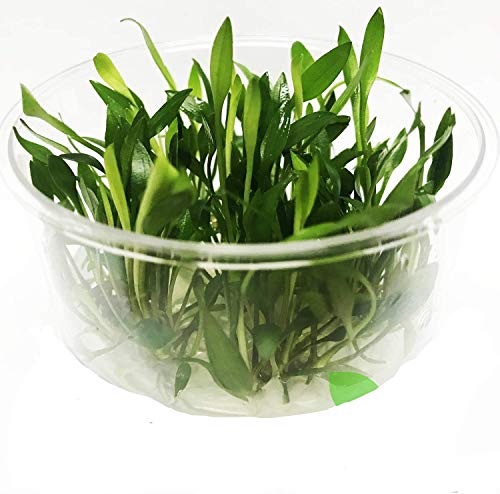
Last update on 2024-04-09 / Commissions Earned / Images from Amazon Product Advertising API
10. African Water Fern (Bolbitis heudelotii)

Verdict – African water fern is slow growing, especially the first few months, but it’s hardy, beautiful and a great background plant for larger tanks.
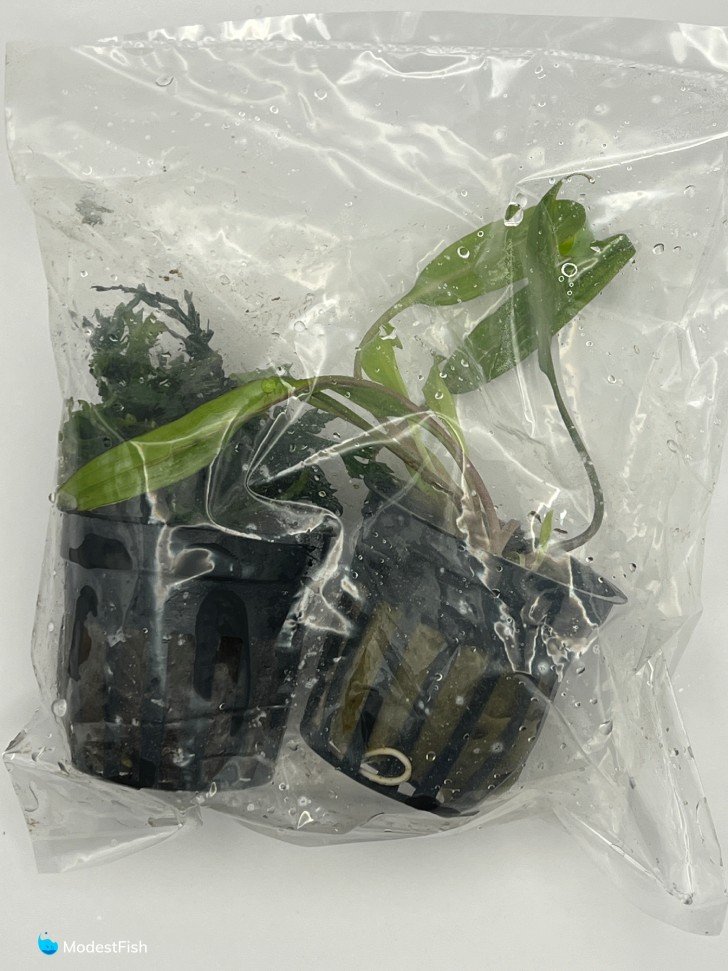
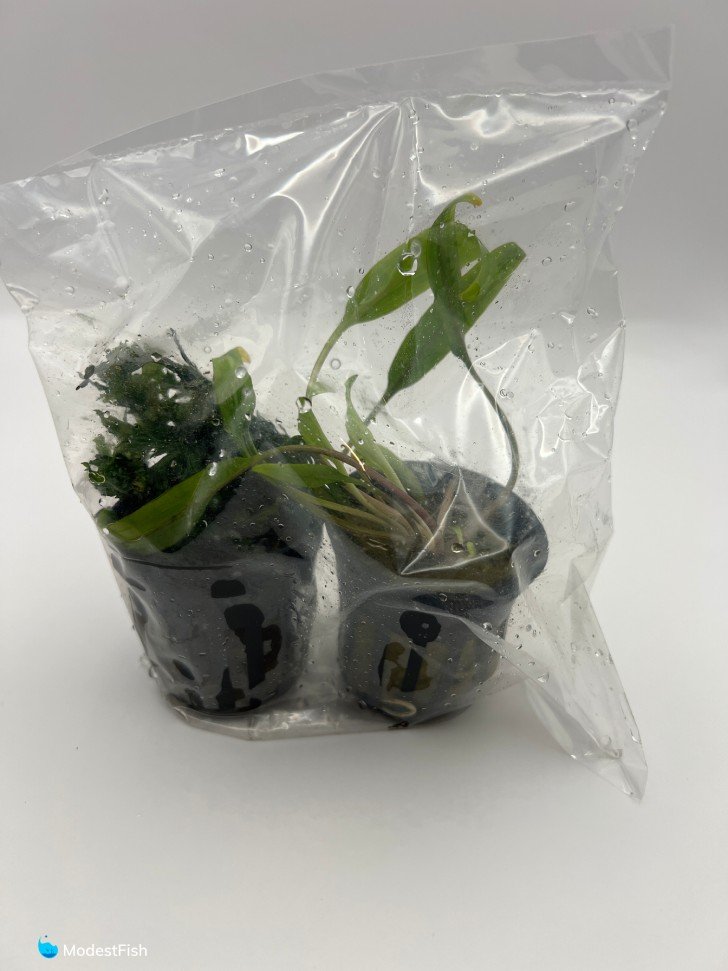
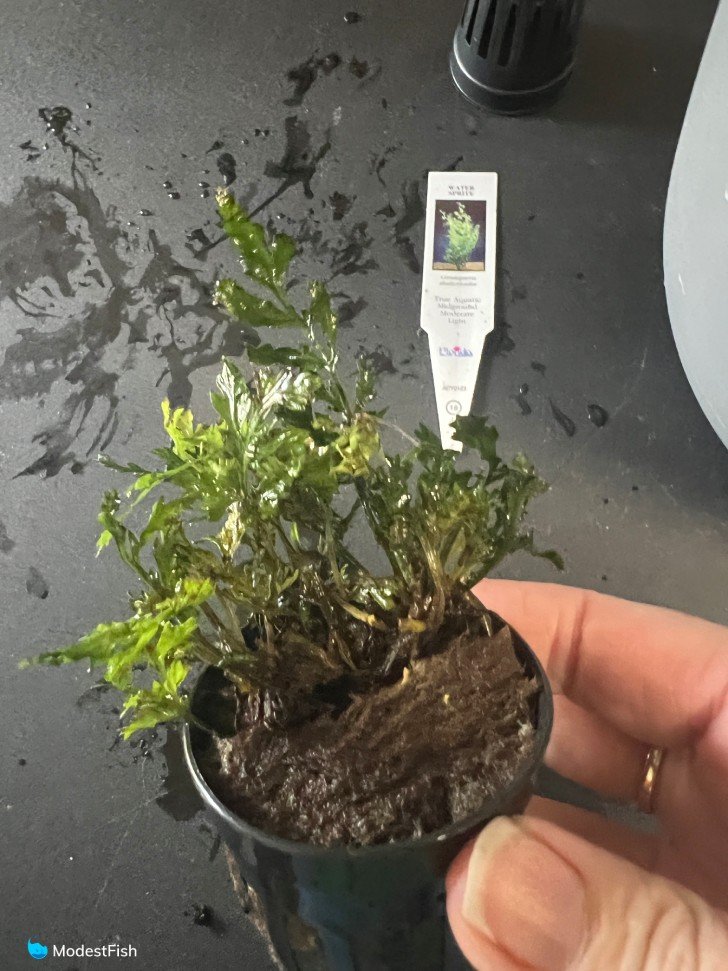
I really love African water fern; I have it in three of my tanks.
I’ve had the typical experience with this plant. It was a little slow to get established. It really didn’t grow for the first few months, and when it did start, the growth rate has been rather slow, but steady.
Because of the shape and texture of the leaves, it can be hard to clean algae off. I’ve found that Amano shrimp or otocinclus catfish are the best ways to keep it cleaned off.
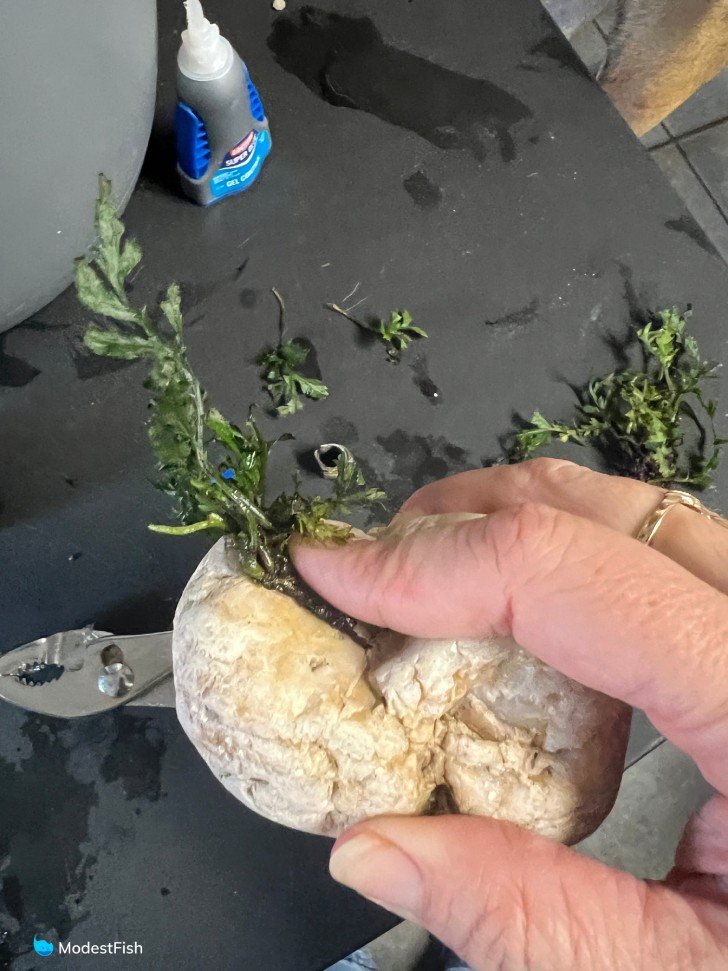
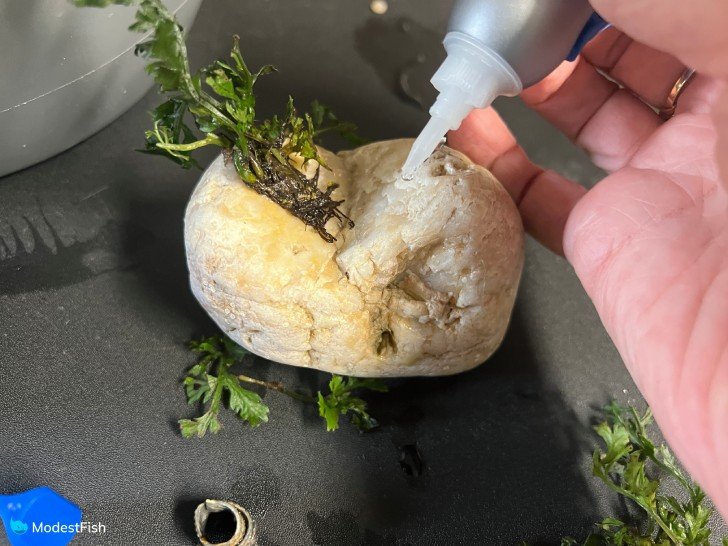
But, I’ve found this species thrives on benign neglect. It’s another epiphyte, so I can just glue small pieces, usually just a piece of rhizome and a few leaves, onto a rock and put it at the back of the tank. Over time, it has grown into a rather large jungles of fronds, which is great for me because I really love the look of terrestrial ferns.
The slow growth rate means it doesn’t eat up a lot of nutrients while it’s small, but it has seemed to really make a difference once the plant grew large.
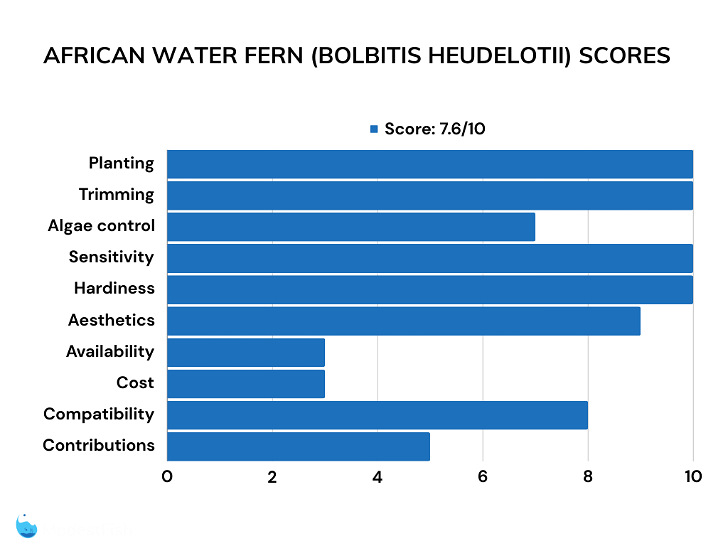
Pros:
- Beautiful, looks like a terrestrial fern
- Makes a great background plant for large tanks
- Tough and resilient
- Easy to plant, easy to trim
Cons:
- Slow to get established and slow growth rate
- Algae control can be a little bothersome
- Doesn’t contribute much to water parameters until it gets large
- Not good for small tanks

Last update on 2024-04-09 / Commissions Earned / Images from Amazon Product Advertising API
11. Cryptocoryne lutea
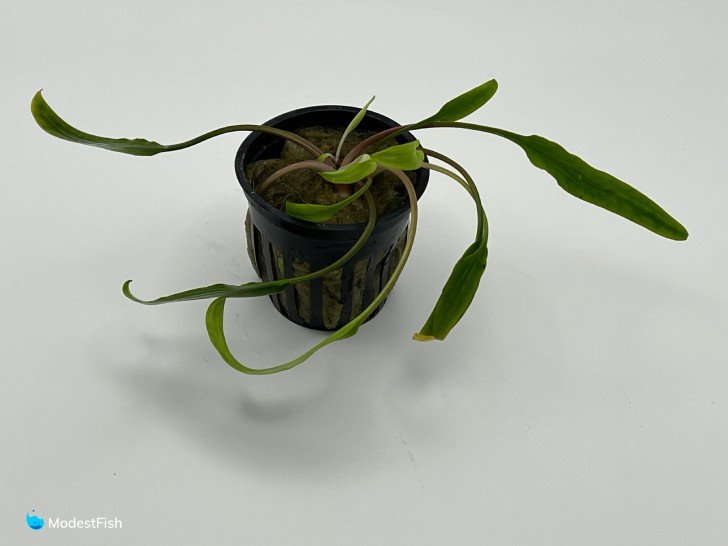
Verdict – this is a gorgeous foreground plant in medium to large tanks and will spread along and cover the substrate in a messy carpet, but it’s very sensitive to changes in the water.
Cryptocoryne lutea is one of my favorite foreground plants. This is a heavy root-feeding plant that will need to draw nutrients from the substrate. I’ve had the best luck with clay-based substrates that absorb the liquid fertilizers I add to the water column.
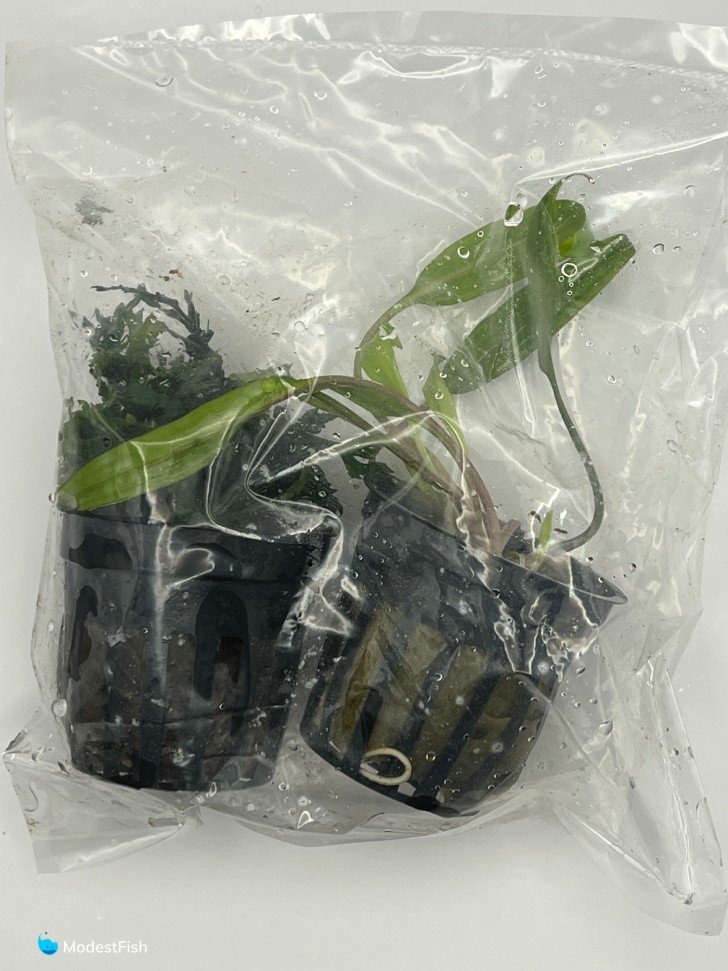
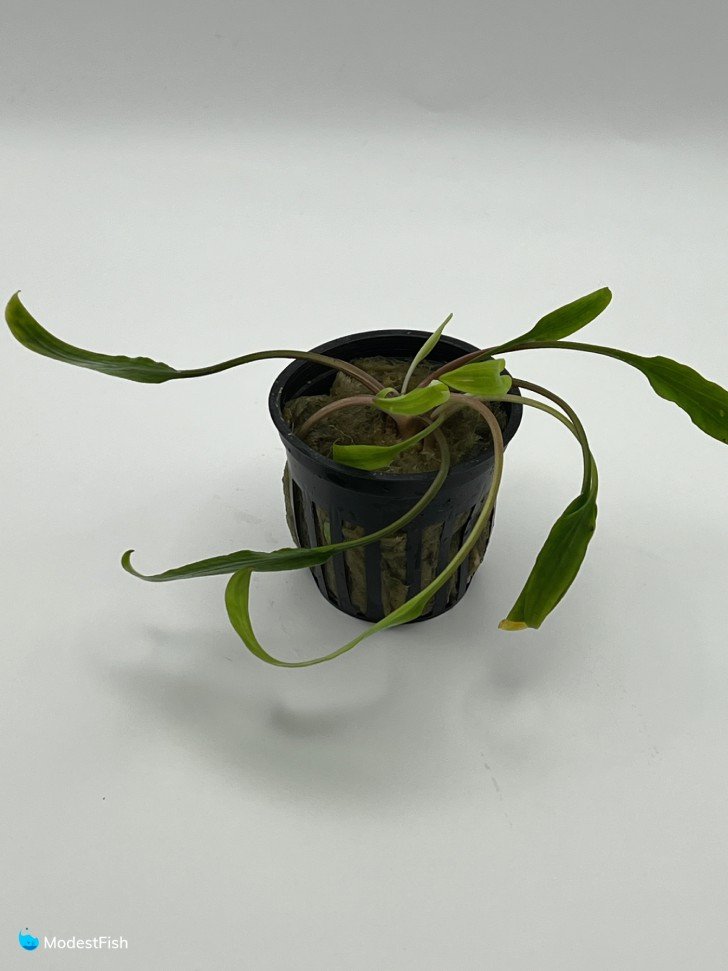
I love the look of this plant, with brown curved stems that sprout green, dagger-like leaves that offer a great contrast in color.
I like that this crypt species is kind of in the middle as far as size goes. It grows to around 6 inches (15 centimeters) tall. I love how bottom feeding fish scoot around in it, like a little jungle.
But, as much as I love this plant, it should be noted that it can be very sensitive. Crypts are notorious for “melting” if there are major changes in water parameters.
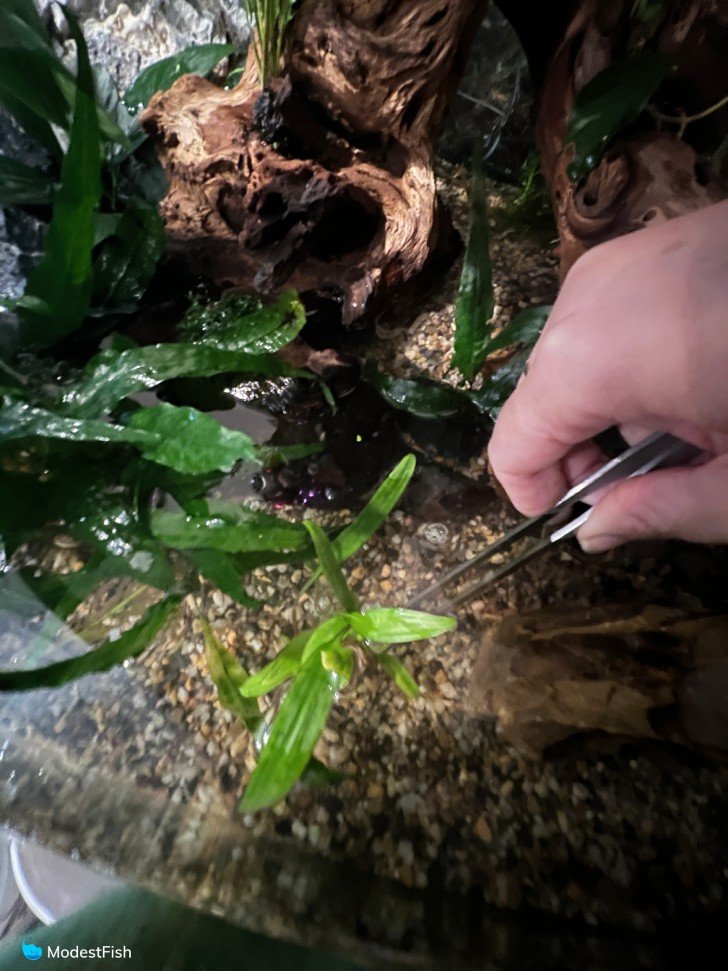

Basically, all of the leaves will suddenly die back and it will seem like the plant is a lost cause. Usually, the crypt bounces back and starts to put out new leaves after a week or so, but it can be distressing when all of your lovely plants rapidly die back to nothing but roots.
Be warned, this can often happen when this plant is first added to a new tank. Give it a week to recover, you should see new leaves start to sprout.
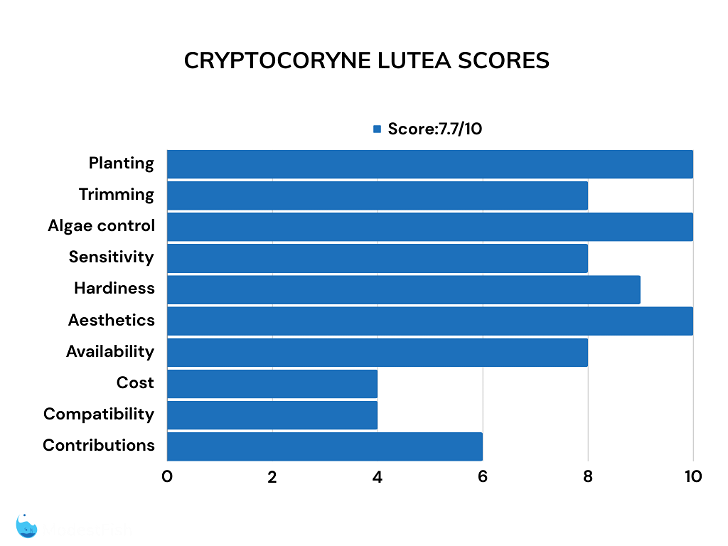
Pros:
- Excellent, low light foreground plant
- Spreads along the substrate, filling open spaces
- Provides excellent cover for small fish
- Good for medium to large tanks
Cons:
- Needs a nutrient rich substrate
- Very sensitive to changes in water parameters
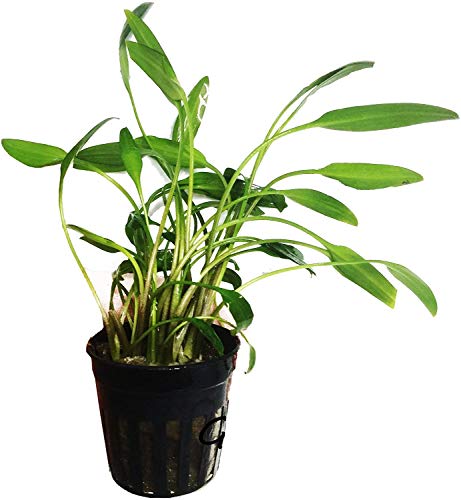
Last update on 2024-04-09 / Commissions Earned / Images from Amazon Product Advertising API
12. Hornwort (Ceratophyllum demersum)

Verdict – hortwort is a fast growing plant that can eat up a lot of nitrate, but getting it established can be tricky.
I love hornwort, also known as coon tail, the way it’s shaped is very beautiful to me. Its bushy tails are made up of lots of needle-like leaves that provide excellent cover for fry and shrimplets.
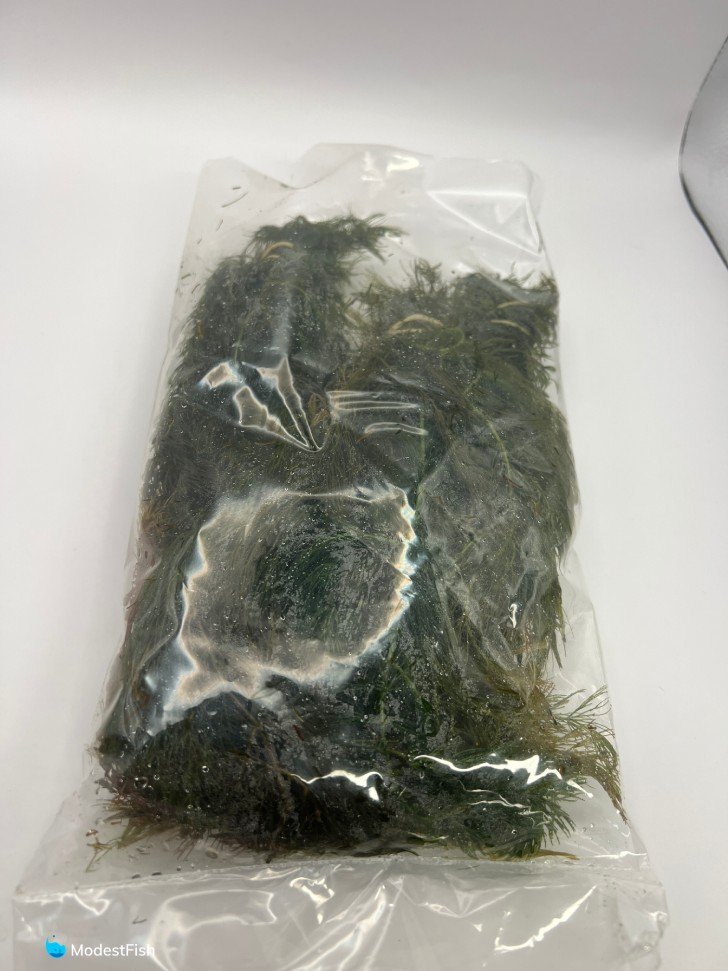
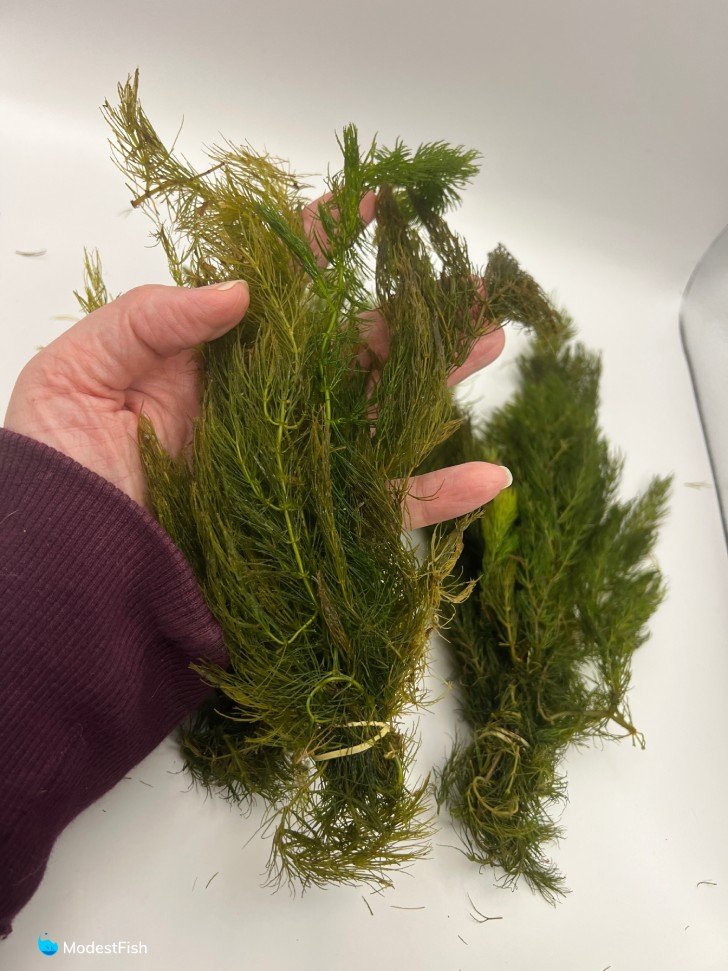
In my tanks, it’s always been a rapidly growing plant that has a positive effect on the tank’s water parameters. It’s a stem plant that eats nutrients straight from the water column.
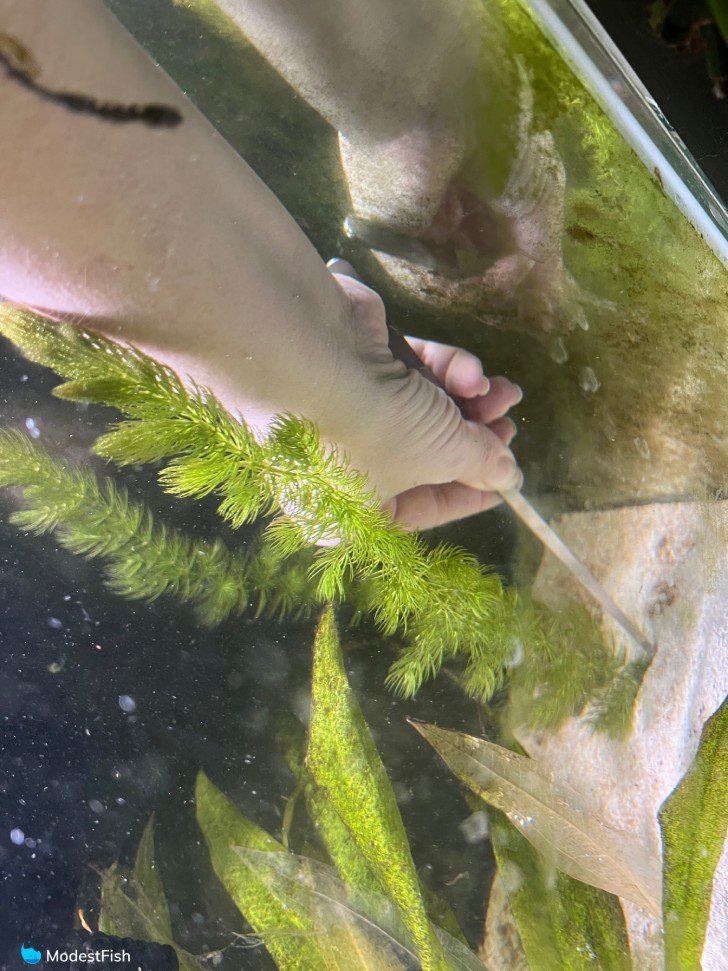
The problem with hornwort is getting it established in the tank. It often melts back, losing its leaves, leaving just the skinny stem.
I’ve always had it bounce back and start growing like crazy again, but this stage can really be a pain.
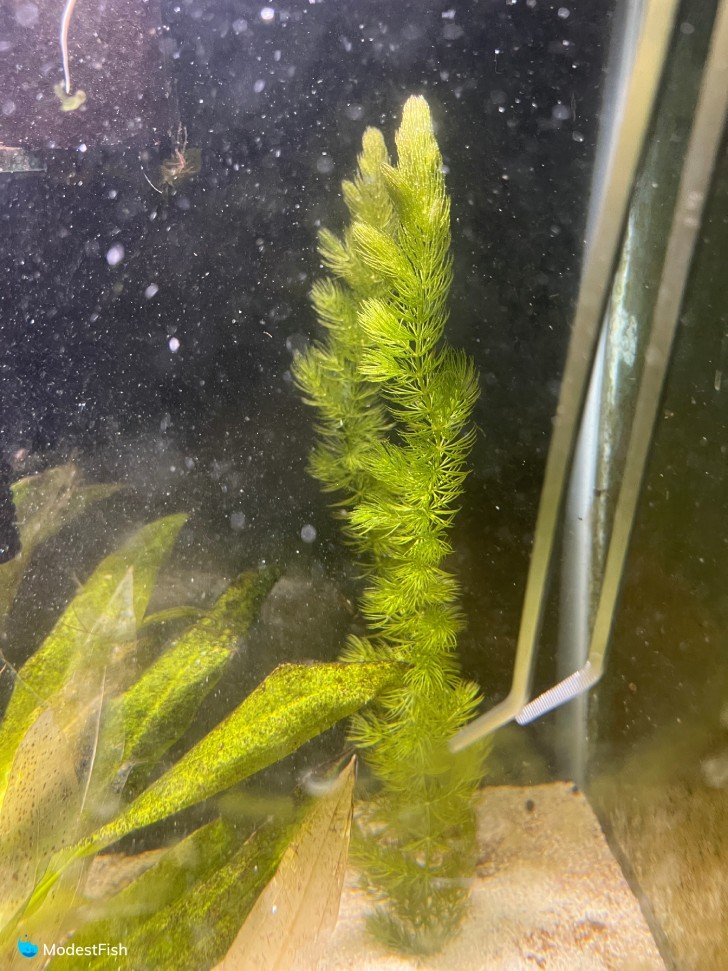
The needles are very tough and difficult to clean up. They can make a huge mess all over the aquarium, and they’re hard to get off the bottom of the tank. I resorted to grabbing handfuls off the substrate when I did water changes.
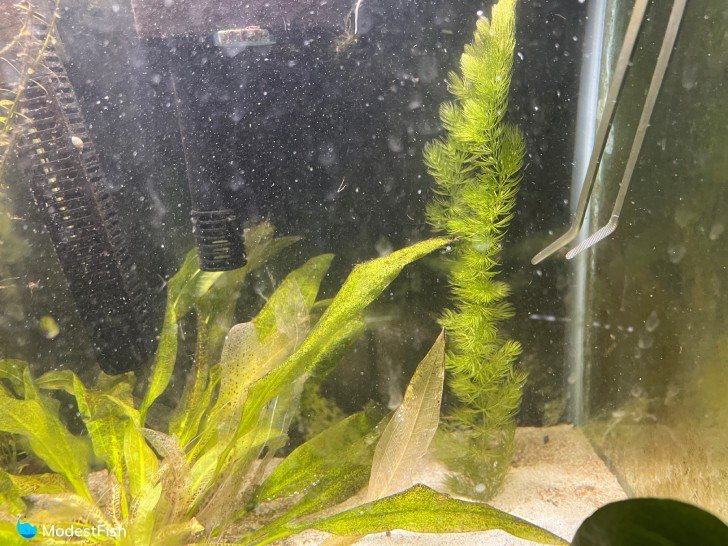
But, once it recovers, and starts growing like crazy, it’s all worth it.
Because this plant grows so much and gets quite large, I would recommend it for tanks that are 30 gallons (113 liters) or larger.
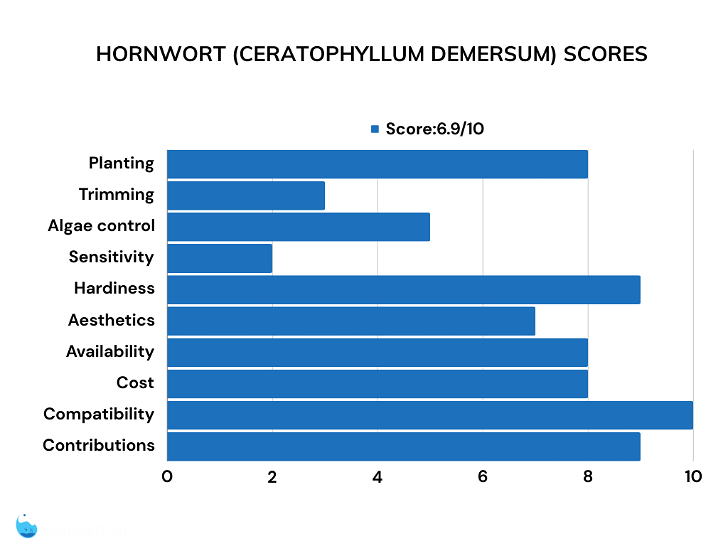
Pros:
- Large plant that lends a very natural look
- Grows quickly and eats up nitrate in the water column
- Beautiful shape
- Great for fry and shrimp tanks
Cons:
- Can lose all its needles while getting established and make a mess
- Too big and fast growing for smaller tanks

Last update on 2024-04-10 / Commissions Earned / Images from Amazon Product Advertising API
13. Anacharis (Elodea sp.)
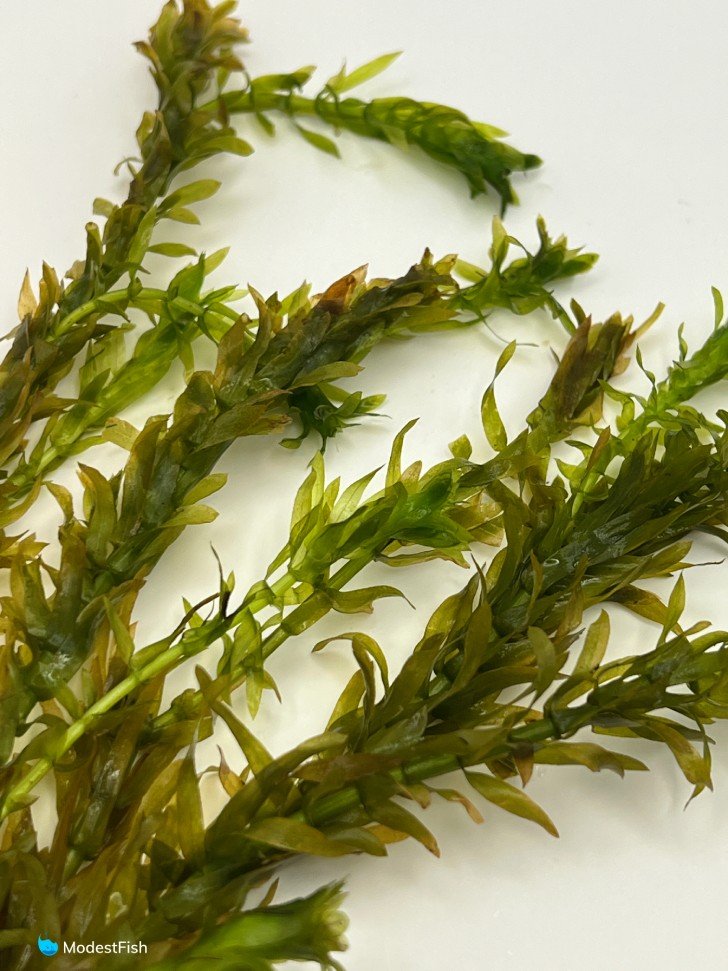
Verdict – anacharis grows very quickly, so it can be a pain to trim, but it does a great job removing nutrients from the water column.
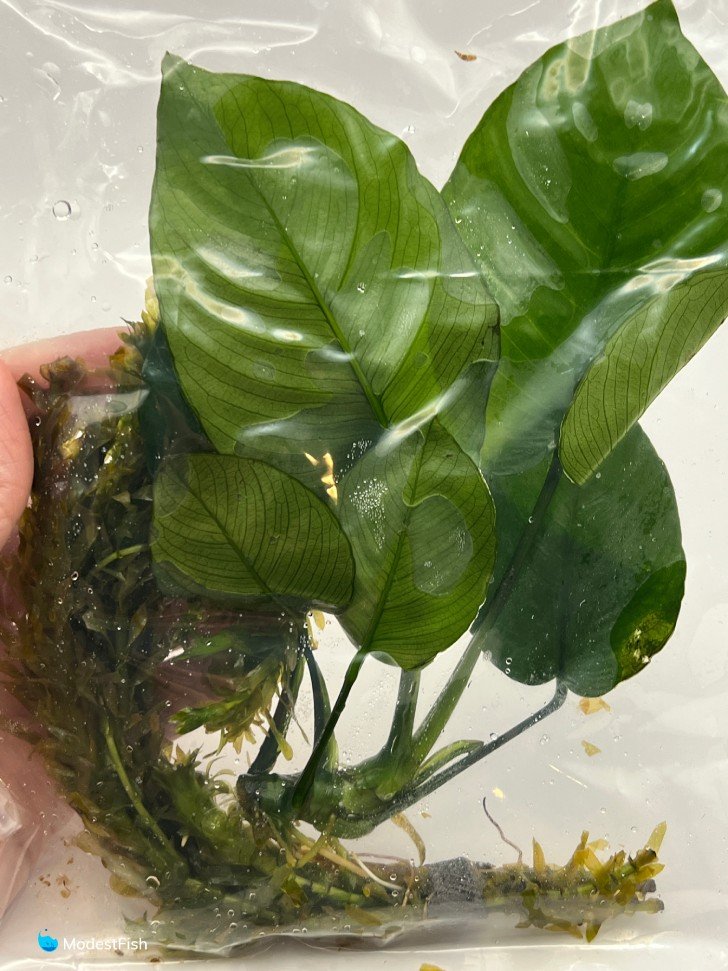
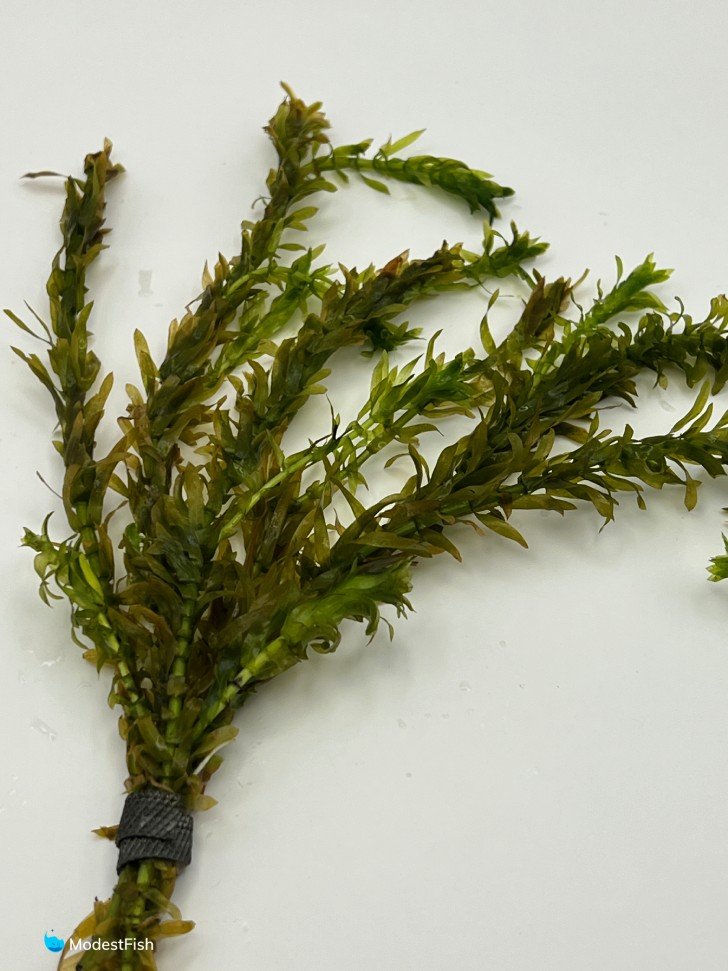
Anacharis is a fast growing stem plant, meaning it feeds directly from the water column instead of through its roots.
It does put out roots, but these are for anchoring the plant, not feeding.
And when I say it grows fast, I mean really fast. Under medium light or higher, you’ll swear you can see it growing by the minute.
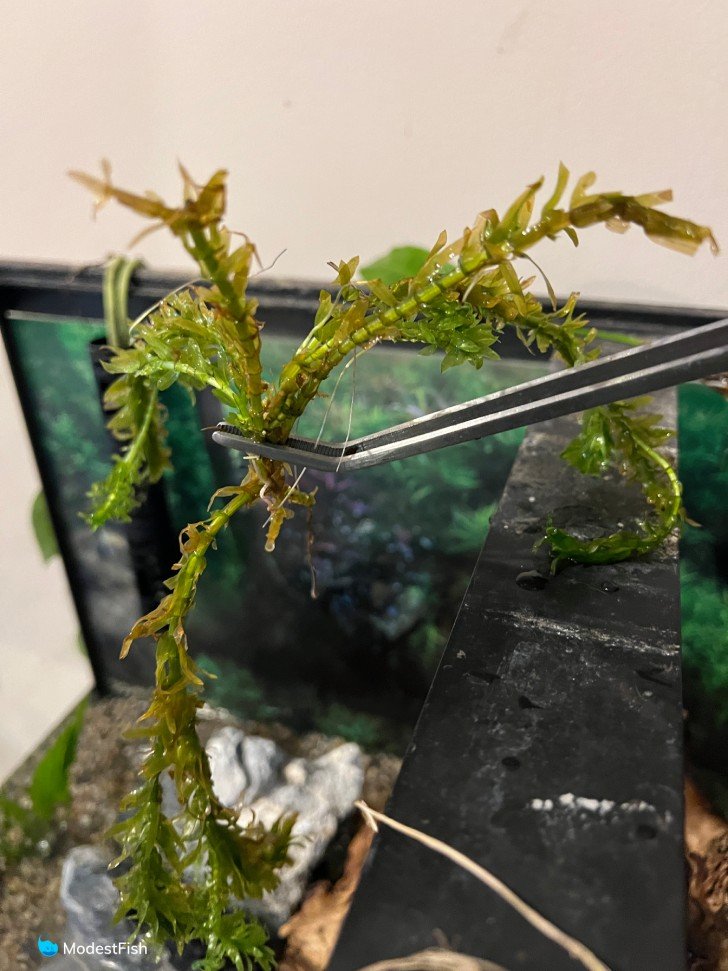
But, I found that all that growth meant I needed to trim it frequently. You can trim off the top of the plant and then root the trimmings to make new plants. Or you can replant the tops and discard the bottom portion of the plant.
I usually discard the bottom portion of the plant because it can start to look raggedy and ugly.
It’s kinda a pain in the butt to get new cuttings to stay down in the substrate. I usually put rocks around the base of the cuttings to help weigh them down.
So, yes, it requires some maintenance, but it’s also one of the top plants that I recommend if you’re trying to reduce nitrates in a tank.
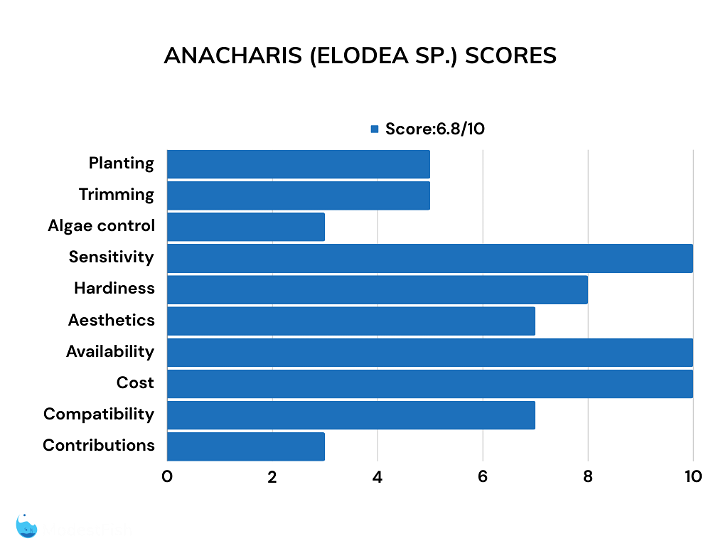
Pros:
- Super easy plant
- Propagate just by snipping off portions of stem
- Fast growth eats up nitrate quickly
Cons:
- Requires frequent trimming
- Hard to keep algae off of it
- Can be a pain to plant new trimmings
- Not the best looking plant

Last update on 2024-04-09 / Commissions Earned / Images from Amazon Product Advertising API
14. Marimo Moss Balls (Aegagropila linnaei)
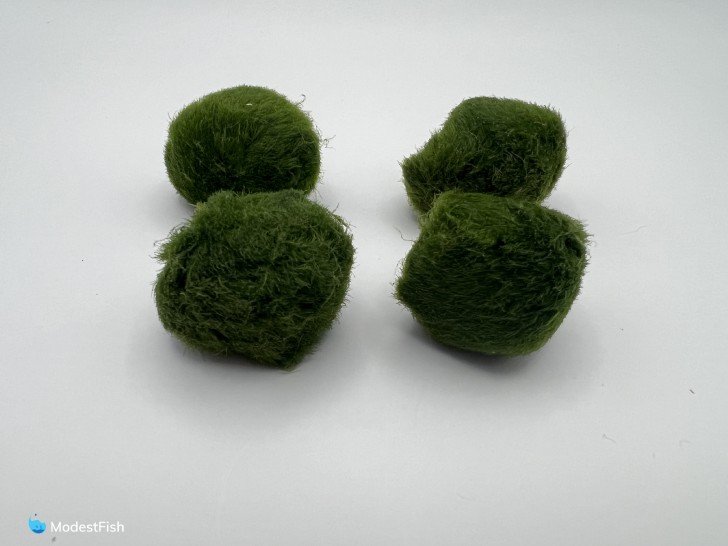
Verdict – these slow growing little moss balls are really cute and simple to care for.
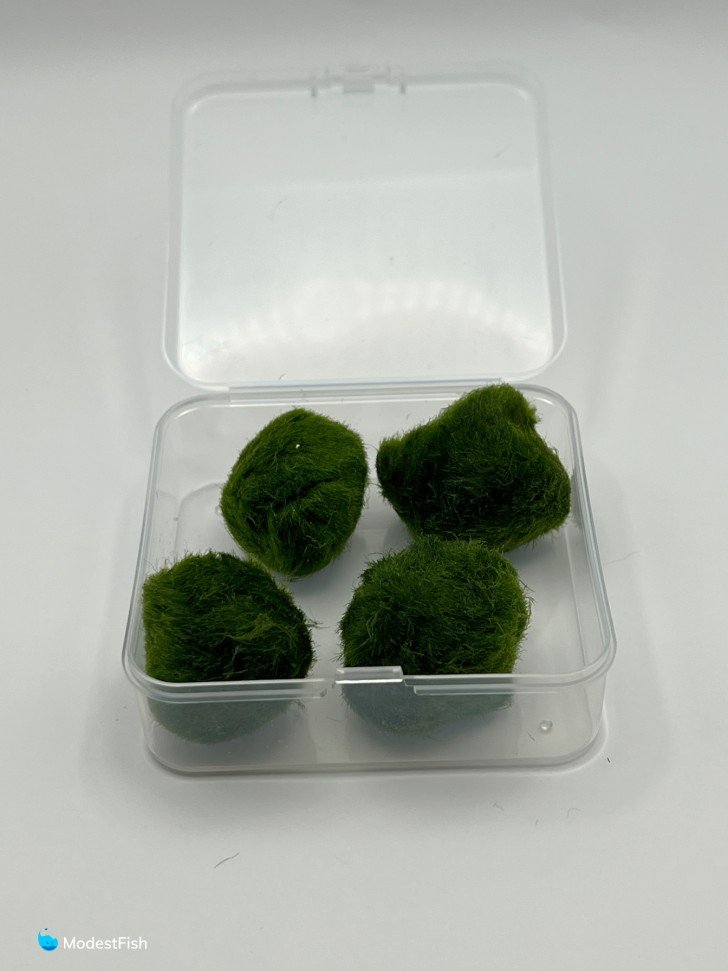
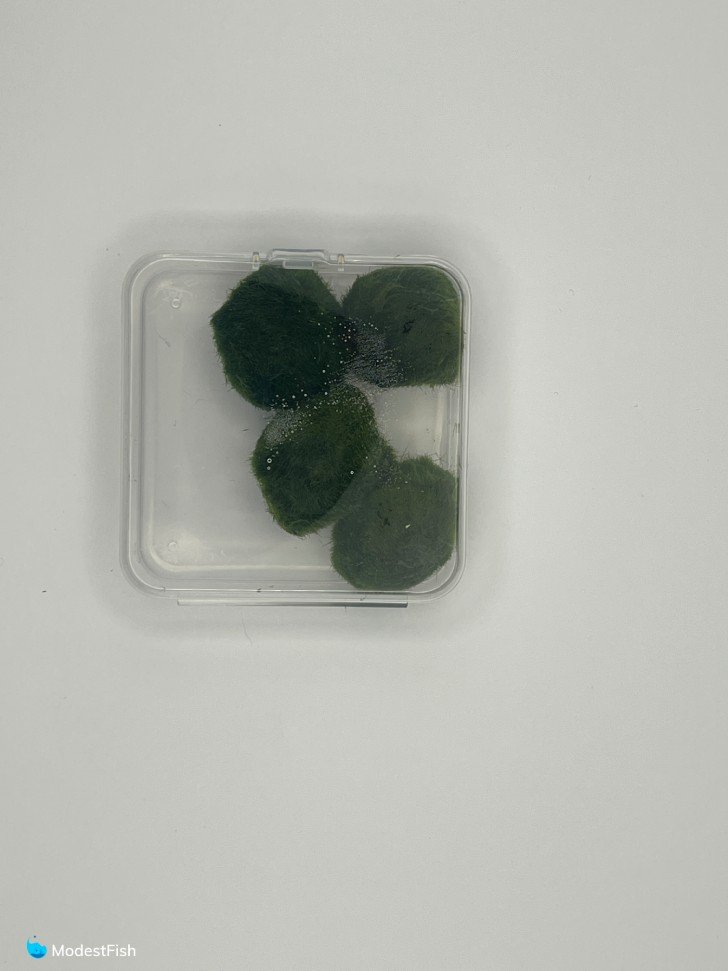
Marimo moss balls are a cool little addition to any aquarium. I tend to keep them in shrimp tanks. My shrimp love to eat detritus off the surface of the moss balls.
All I had to do to plant them was to just place them on the bottom of the tank. Yep, that’s it.
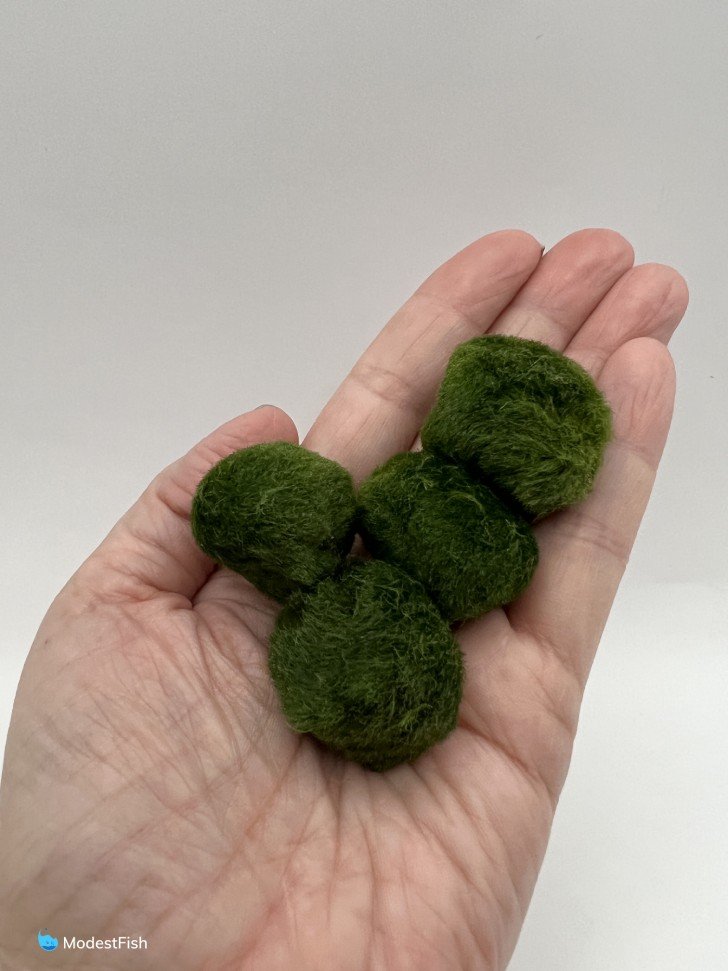
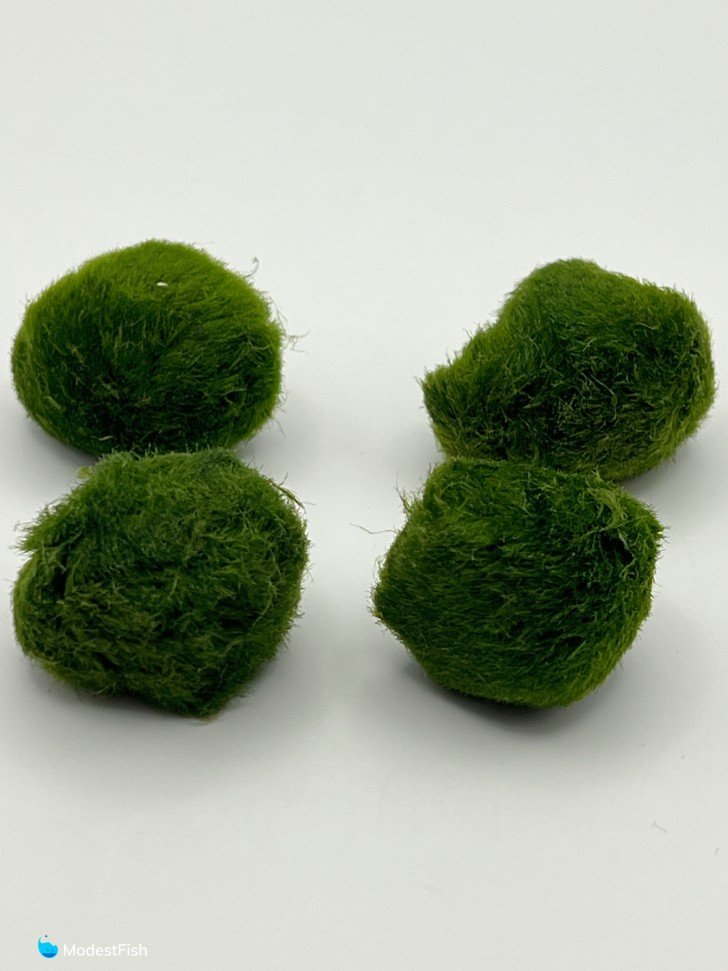
I’ve found maintaining them to also be a breeze. All I have to do is squeeze them out occasionally to get out trapped detritus and make sure to turn them periodically so that all sides get some light.
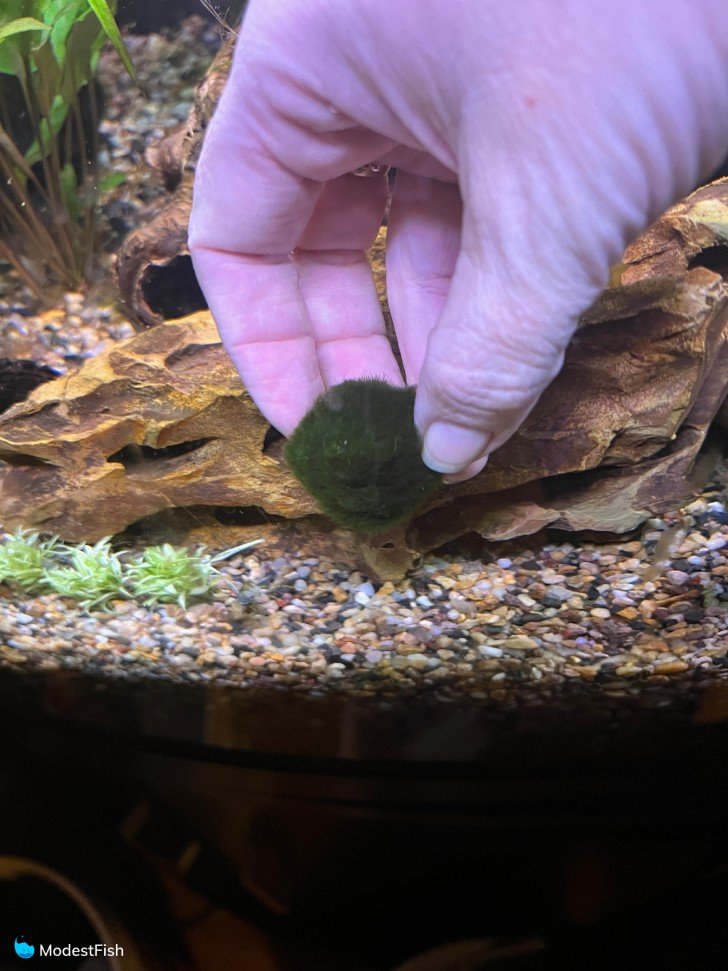
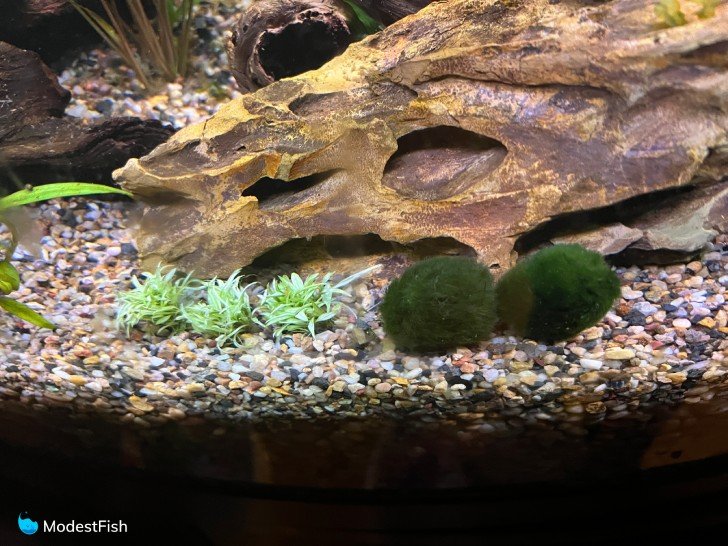
The only bummer about these little guys is that they grow very, very slowly. That means they don’t really contribute much to eating nitrate. But, that also means I don’t have to trim them!
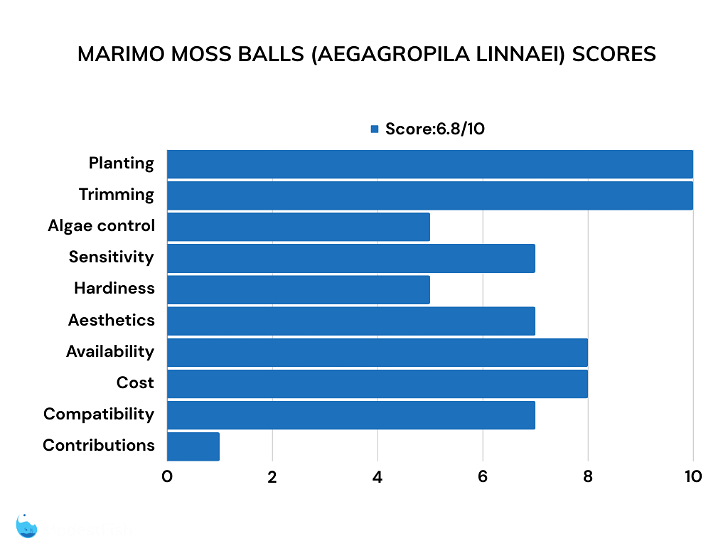
Pros:
- Cute round shape
- Beloved by ornamental shrimp
- Easy to plant and maintain
Cons:
- Slow growth rate
- Doesn’t contribute much to water parameters

Last update on 2024-04-09 / Commissions Earned / Images from Amazon Product Advertising API
Final Verdict on the Plants
There are a lot of great plants on this list, all with their own pros and cons.
Plain and simple, if you want some easy plants that you can pretty much grow in a puddle, Java fern and anubias are the way to go.
They don’t grow very fast, but this also means that they don’t need a lot of trimming or maintenance.
Both can grow in low light, don’t need a fancy substrate, are easy to get algae off of and only need to be fertilized once a month.
These plants are what most beginners should start with.
Once you’ve got a little more experience, you can branch out into things like crypts or water sprite.
I hope you find this article helpful.
I wish you and your fish the very best!

You have site provdes an awesome amount of information in an easy to comprehend manner. Thanks for helping me sort through the white noise.
Thanks for the information. I’m excited
Very useful information and easy guide for beginners. Thanks a lot. Great job.
Thank you, very informative as I am a beginner, so I think I will start of with 1 live plant to see how I go before putting in more.
Whoopsie 😀 Swapped it out. Thanks for pointing that out. Have a nice day
Hello. I read somewhere that you should only start with one or two plants. Not too many all at once. Is that correct?
Hello, Monica. You can start with more plants. I have never heard this rule before
Thank you for the article. This helped me immensely I am able to choose the correct aquarium plants
Hey there! Thanks so much for your info, really helped me out on deciding how to create a planted tank.
Love your site. Very informative but not overwhelming. When a person can explain complicated matters in the simplest of terms and in a clear, concise, intelligent manner, that’s the real test of an expert and how knowledgeable they are. Ty soooo much for your expert advice and sharing your hard earned knowledge and experience!